Sercomm IP806GA 802.11 b/g Wireless ADSL Router User Manual
Sercomm Corporation 802.11 b/g Wireless ADSL Router
Sercomm >
User Manual

IP806GA/GB
Wireless ADSL Router
802.11g/802.11b Wireless Access Point
ADSL Modem
NAT Router
4-Port Switching Hub
User's Guide

i
Table of Contents
CHAPTER 1 INTRODUCTION .............................................................................................1
Wireless ADSL Router Features......................................................................................1
Package Contents ..............................................................................................................3
Physical Details..................................................................................................................4
CHAPTER 2 INSTALLATION...............................................................................................6
Requirements.....................................................................................................................6
Procedure...........................................................................................................................6
CHAPTER 3 SETUP ................................................................................................................8
Overview ............................................................................................................................8
Configuration Program ....................................................................................................9
Setup Wizard ...................................................................................................................11
LAN Screen......................................................................................................................13
WEP Screen......................................................................................................................15
Password Screen..............................................................................................................16
CHAPTER 4 PC CONFIGURATION ..................................................................................17
Overview ..........................................................................................................................17
Windows Clients..............................................................................................................17
Macintosh Clients............................................................................................................29
Linux Clients....................................................................................................................29
Other Unix Systems.........................................................................................................29
Wireless Station Configuration......................................................................................30
CHAPTER 5 OPERATION AND STATUS.........................................................................31
Operation .........................................................................................................................31
Status Screen....................................................................................................................31
Connection Status - PPPoE & PPPoA...........................................................................33
Connection Details - Dynamic IP Address....................................................................34
Connection Details - Fixed IP Address..........................................................................36
CHAPTER 6 ADVANCED FEATURES ..............................................................................37
Overview ..........................................................................................................................37
Dynamic DNS (Domain Name Server) ..........................................................................37
Firewall Rules ..................................................................................................................39
Services.............................................................................................................................39
Schedule............................................................................................................................39
URL Filter........................................................................................................................47
Virtual Servers.................................................................................................................48
CHAPTER 7 ADVANCED ADMINISTRATION...............................................................51
Overview ..........................................................................................................................51
Config File........................................................................................................................52
Logs...................................................................................................................................53
Network Diagnostics .......................................................................................................55
E-mail ...............................................................................................................................56
Remote Admin.................................................................................................................58
Routing.............................................................................................................................60
Router Upgrade...............................................................................................................64
ii
APPENDIX A TROUBLESHOOTING................................................................................65
Overview ..........................................................................................................................65
General Problems............................................................................................................65
Internet Access.................................................................................................................65
Wireless Access................................................................................................................66
APPENDIX B ABOUT WIRELESS LANS..........................................................................68
Modes ...............................................................................................................................68
BSS/ESS............................................................................................................................68
Channels...........................................................................................................................69
WEP..................................................................................................................................69
Wireless LAN Configuration..........................................................................................69
APPENDIX C SPECIFICATIONS .......................................................................................70
Multi-Function Wireless ADSL Router.........................................................................70
Wireless Interface............................................................................................................70
Regulatory Approvals.....................................................................................................71
P/N: 9560LB0001
Copyright 2003. All Rights Reserved.
Document Version: 1.2
All trademarks and trade names are the properties of their respective owners.
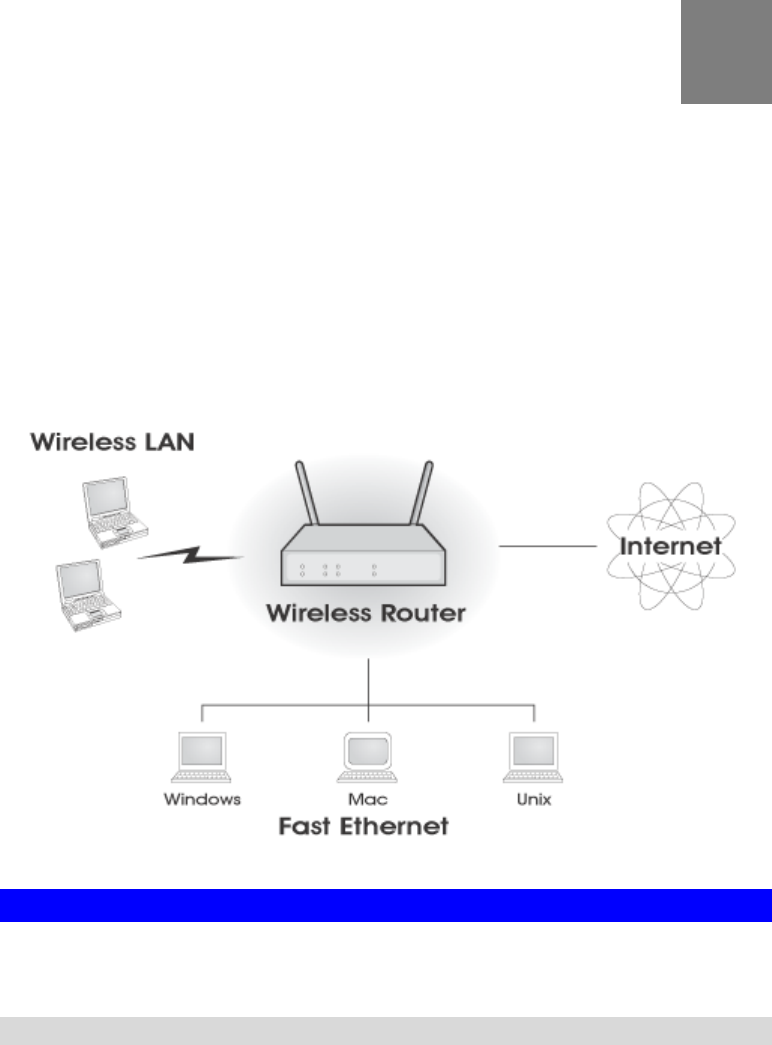
1
Chapter 1
Introduction
This Chapter provides an overview of the Wireless ADSL Router's features
and capabilities.
Congratulations on the purchase of your new Wireless ADSL Router. The Wireless ADSL
Router is a multi-function device providing the following services:
• ADSL Modem.
• Shared Broadband Internet Access for all LAN users.
• Wireless Access Point for 802.11b and 802.11g Wireless Stations.
• 4-Port Switching Hub for 10BaseT or 100BaseT connections.
Figure 1: Wireless ADSL Router
Wireless ADSL Router Features
The Wireless ADSL Router incorporates many advanced features, carefully designed to
provide sophisticated functions while being easy to use.
Internet Access Features
• Shared Internet Access. All users on the LAN or WLAN can access the Internet
through the Wireless ADSL Router, using only a single external IP Address. The local
(invalid) IP Addresses are hidden from external sources. This process is called NAT
(Network Address Translation).
• Built-in ADSL Modem. The Wireless ADSL Router has a built-in ADSL modem,
supporting all common ADSL connections.
• IPoA, PPPoE, PPPoA, Direct Connection Support. The Wireless ADSL Router
supports all common connection methods.
1

Wireless ADSL Router User Guide
2
• Auto-detection of Internet Connection Method. The Wireless ADSL Router can test
your ADSL and Internet connection to determine the connection method used by your ISP.
• Fixed or Dynamic IP Address. On the Internet (WAN port) connection, the Wireless
ADSL Router supports both Dynamic IP Address (IP Address is allocated on connection)
and Fixed IP Address.
Advanced Internet Functions
• Application Level Gateways (ALGs). Applications which use non-standard
connections or port numbers are normally blocked by the Firewall. The ability to define
and allow such applications is provided, to enable such applications to be used normally.
• Virtual Servers. This feature allows Internet users to access Internet servers on your
LAN. The required setup is quick and easy.
• URL Filter. Use the URL Filter to block access to undesirable Web sites by LAN users.
• Logs. Define what data is recorded in the Logs, and optionally send log data to a Syslog
Server. Log data can also be E-mailed to you.
• Firewall. As well as the built-in firewall to protect your LAN, you can define Firewall
Rules to determine which incoming and outgoing traffic should be permitted.
• Dynamic DNS Support. DDNS, when used with the Virtual Servers feature, allows
users to connect to Servers on your LAN using a Domain Name, even if you have a
dynamic IP address which changes every time you connect.
• VPN Pass through Support. PCs with VPN (Virtual Private Networking) software
using PPTP, L2TP and IPSec are transparently supported - no configuration is required.
Wireless Features
• Standards Compliant. The Wireless ADSL Router complies with the IEEE802.11g
(DSSS) specifications for Wireless LANs.
• Supports both 802.11b and 802.11g Wireless Stations. The 802.11g standard
provides for backward compatibility with the 802.11b standard, so both 802.11b and
802.11g Wireless stations can be used simultaneously.
• Speeds to 54Mbps. All speeds up to the 802.11g maximum of 54Mbps are supported.
• WEP support. Support for WEP (Wired Equivalent Privacy) is included. Key sizes of
64 Bit and 128 Bit are supported.
• Wireless MAC Access Control. The Wireless Access Control feature can check the
MAC address (hardware address) of Wireless stations to ensure that only trusted Wireless
Stations can access your LAN.
• Simple Configuration. If the default settings are unsuitable, they can be changed
quickly and easily.
LAN Features
• 4-Port Switching Hub. The Wireless ADSL Router incorporates a 4-port 10/100BaseT
switching hub, making it easy to create or extend your LAN.
• DHCP Server Support. Dynamic Host Configuration Protocol provides a dynamic IP
address to PCs and other devices upon request. The Wireless ADSL Router can act as a
DHCP Server for devices on your local LAN and WLAN.
• Multi Segment LAN Support. LANs containing one or more segments are supported,
via the Wireless ADSL Router's RIP (Routing Information Protocol) support and built-in
static routing table.

Introduction
3
Configuration & Management
• Easy Setup. Use your WEB browser from anywhere on the LAN or WLAN for
configuration.
• Configuration File Upload/Download. Save (download) the configuration data from
the Wireless ADSL Router to your PC, and restore (upload) a previously-saved
configuration file to the Wireless ADSL Router.
• Remote Management. The Wireless ADSL Router can be managed from any PC on
your LAN. And, if the Internet connection exists, it can also (optionally) be configured via
the Internet.
• Network Diagnostics. You can use the Wireless ADSL Router to perform a Ping or
DNS lookup.
Security Features
• Password - protected Configuration. Optional password protection is provided to
prevent unauthorized users from modifying the configuration data and settings.
• Wireless LAN Security. WEP (Wired Equivalent Privacy) is supported, as well as
Wireless access control to prevent unknown wireless stations from accessing your LAN.
• NAT Protection. An intrinsic side effect of NAT (Network Address Translation)
technology is that by allowing all LAN users to share a single IP address, the location and
even the existence of each PC is hidden. From the external viewpoint, there is no network,
only a single device - the Wireless ADSL Router.
• Firewall. All incoming data packets are monitored and all incoming server requests are
filtered, thus protecting your network from malicious attacks from external sources.
• Protection against DoS attacks. DoS (Denial of Service) attacks can flood your
Internet connection with invalid packets and connection requests, using so much
bandwidth and so many resources that Internet access becomes unavailable. The Wireless
ADSL Router incorporates protection against DoS attacks.
Package Contents
The following items should be included:
• The Wireless ADSL Router Unit
• Power Adapter
• Quick Installation Guide
• CD-ROM containing the on-line manual.
If any of the above items are damaged or missing, please contact your dealer immediately.
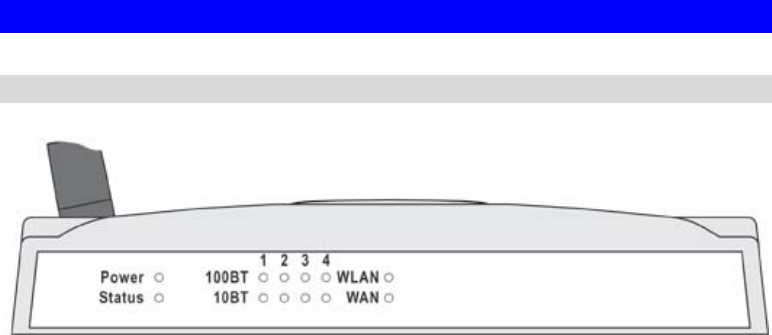
Wireless ADSL Router User Guide
4
Physical Details
Front-mounted LEDs
Figure 2: Front Panel
Power LED On - Power on.
Off - No power.
Status (Red)
LED On - Error condition.
Off - Normal operation.
Blinking - This LED blinks during start up, and during a Firmware
Upgrade.
LAN For each port, there are 2 LEDs, to indicate the connection speed
(10BaseT or 100BaseT) of each port.
If neither LED is on, there is no active connection on the corresponding
LAN port.
WLAN LED On - Idle.
Off - Error - No Wireless connection available.
Flashing - Data is being transmitted or received via the Wireless access
point. This includes "network traffic" as well as user data.
WAN On - ADSL connection to your ISP is established.
Off - No ADSL connection to your ISP.
Flashing - Data is being transmitted or received via the ADSL connection.

Introduction
5
Rear Panel
Figure 3: Rear Panel
Power port Connect the supplied power adapter here.
10/100BaseT
LAN connections Use standard LAN cables (RJ45 connectors) to connect your PCs to
these ports.
Note:
Any LAN port on the Wireless ADSL Router will automatically
function as an "Uplink" port when required. Just connect any port to
a normal port on the other hub, using a standard LAN cable.
Reset Button This button has two (2) functions:
• Reboot. When pressed and released, the Wireless ADSL Router
will reboot (restart).
• Clear All Data. This button can also be used to clear ALL data
and restore ALL settings to the factory default values.
To Clear All Data and restore the factory default values:
1. Power Off.
2. Hold the Reset Button down while you Power On.
3. Keep holding the Reset Button for a few seconds, until the RED
LED has flashed TWICE.
4. Release the Reset Button. The Wireless ADSL Router is now
using the factory default values.
WAN port
(ADSL port) Connect this port to your ADSL line.
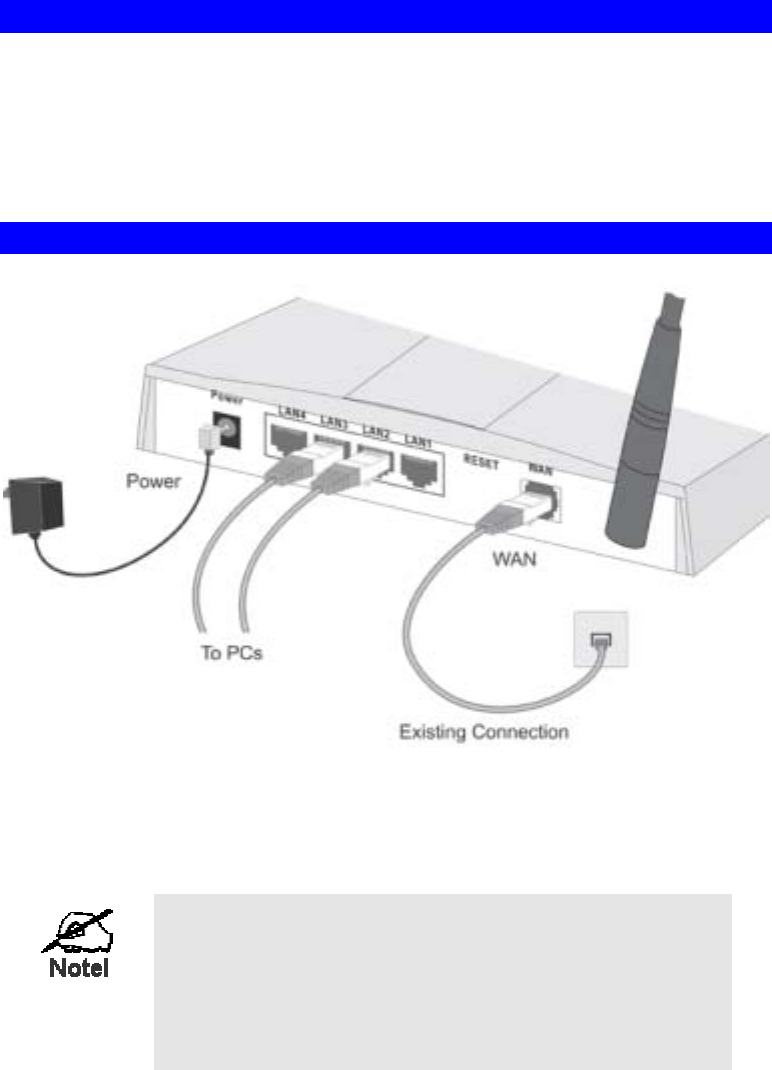
6
Chapter 2
Installation
This Chapter covers the physical installation of the Wireless ADSL Router.
Requirements
• Network cables. Use standard 10/100BaseT network (UTP) cables with RJ45 connectors.
• TCP/IP protocol must be installed on all PCs.
• For Internet Access, an Internet Access account with an ISP, and a DSL connection.
• To use the Wireless Access Point, all Wireless devices must be compliant with the IEEE
802.11g or IEEE 802.11b specifications.
Procedure
Figure 4: Installation Diagram
1. Choose an Installation Site
Select a suitable place on the network to install the Wireless ADSL Router.
For best Wireless reception and performance, the Wireless
ADSL Router should be positioned in a central location with
minimum obstructions between the Wireless ADSL Router
and the PCs.
Also, if using multiple Access Points, adjacent Access
Points should use different Channels.
Installation
7
2. Connect LAN Cables
Use standard LAN cables to connect PCs to the Switching Hub ports on the Wireless
ADSL Router. Both 10BaseT and 100BaseT connections can be used simultaneously.
If required, connect any port to a normal port on another Hub, using a standard LAN cable.
Any LAN port on the Wireless ADSL Router will automatically function as an "Uplink"
port when required.
3. Connect ADSL Cable
Connect your ADSL line to the WAN port on the Wireless ADSL Router.
4. Power Up
• Power on the Cable or DSL modem.
• Connect the supplied power adapter to the Wireless ADSL Router and power up.
Use only the power adapter provided. Using a different one may cause hardware damage
5. Check the LEDs
• The Power LED should be ON.
• The Status LED should flash, then turn Off. If it stays on, there is a hardware error.
• For each LAN (PC) connection, one of the LAN LEDs should be ON (provided the PC is
also ON.)
• The WLAN LED should be ON
• The WAN LED should be ON.
For more information, refer to Front-mounted LEDs in Chapter 1.

8
Chapter 3
Setup
This Chapter provides Setup details of the Wireless ADSL Router.
Overview
This chapter describes the setup procedure for:
• Internet Access
• LAN configuration
• Wireless setup
• Assigning a Password to protect the configuration data.
PCs on your local LAN may also require configuration. For details, see Chapter 4 - PC
Configuration.
Other configuration may also be required, depending on which features and functions of the
Wireless ADSL Router you wish to use. Use the table below to locate detailed instructions for
the required functions.
To Do this: Refer to:
Configure PCs on your LAN. Chapter 4:
PC Configuration
Check Wireless ADSL Router operation and Status. Chapter 5:
Operation and Status
Use any of the following Advanced features:
• Dynamic DNS
• Firewall Rules and Services
• Scheduling
• URL Filter
• Virtual Servers (Port Forwarding)
Chapter 6:
Advanced Features
Use any of the following Administration Configuration
settings or features:
• Config File download/upload
• Logs and E-mailing of logs and alerts
• Network Diagnostics (Ping, DNS Lookup)
• PC Database
• Remote Management
• Routing (RIP and static Routing)
• Firmware Upgrade
Chapter 7
Advanced Administration
3

Setup
9
Configuration Program
The Wireless ADSL Router contains an HTTP server. This enables you to connect to it, and
configure it, using your Web Browser. Your Browser must support JavaScript.
The configuration program has been tested on the following browsers:
• Netscape V4.08 or later
• Netscape 7
• Internet Explorer V5.01 or later
Preparation
Before attempting to configure the Wireless ADSL Router, please ensure that:
• Your PC can establish a physical connection to the Wireless ADSL Router. The PC and
the Wireless ADSL Router must be directly connected (using the Hub ports on the
Wireless ADSL Router) or on the same LAN segment.
• The Wireless ADSL Router must be installed and powered ON.
• If the Wireless ADSL Router's default IP Address (192.168.0.1) is already used by
another device, the other device must be turned OFF until the Wireless ADSL Router is
allocated a new IP Address during configuration.
Using your Web Browser
To establish a connection from your PC to the Wireless ADSL Router:
1. After installing the Wireless ADSL Router in your LAN, start your PC. If your PC is
already running, restart it.
2. Start your WEB browser.
3. In the Address box, enter "HTTP://" and the IP Address of the Wireless ADSL Router, as
in this example, which uses the Wireless ADSL Router's default IP Address:
HTTP://192.168.0.1
4. When prompted for the User name and Password, enter values as follows:
• User name admin
• Password password

Wireless ADSL Router User Guide
10
If you can't connect
If the Wireless ADSL Router does not respond, check the following:
• The Wireless ADSL Router is properly installed, LAN connection is OK, and
it is powered ON. You can test the connection by using the "Ping" command:
• Open the MS-DOS window or command prompt window.
• Enter the command:
ping 192.168.0.1
If no response is received, either the connection is not working, or your
PC's IP address is not compatible with the Wireless ADSL Router's IP
Address. (See next item.)
• If your PC is using a fixed IP Address, its IP Address must be within the range
192.168.0.2 to 192.168.0.254 to be compatible with the Wireless ADSL
Router's default IP Address of 192.168.0.1. Also, the Network Mask must be
set to 255.255.255.0. See Chapter 4 - PC Configuration for details on
checking your PC's TCP/IP settings.
• Ensure that your PC and the Wireless ADSL Router are on the same network
segment. (If you don't have a router, this must be the case.)
• Ensure you are using the wired LAN interface. The Wireless interface can only
be used if its configuration matches your PC's wireless settings.

Setup
11
Setup Wizard
The first time you connect to the Wireless ADSL Router, the Setup Wizard will run
automatically. (The Setup Wizard will also run if the Wireless ADSL Router's default settings
are restored.)
1. Step through the Wizard until finished.
• You need the data supplied by your ISP. Most connection methods require some data
input.
• The common connection types are explained in the tables below.
2. On the final screen of the Wizard, run the test and check that an Internet connection can be
established.
3. If the connection test fails:
• Check all connections, and the front panel LEDs.
• Check that you have entered all data correctly.
Common Connection Types
Type Details ISP Data required
Dynamic
IP Address Your IP Address is allocated
automatically, when you connect
to you ISP.
None.
Static (Fixed)
IP Address Your ISP allocates a permanent
IP Address to you.
Usually, the connection is
"Always on".
IP Address allocated to you, and
related information, such as
Network Mask, Gateway IP
address, and DNS address.
PPPoE, PPPoA You connect to the ISP only when
required. The IP address is
usually allocated automatically.
User name and password.
If using a Static (Fixed) IP
address, you need the IP address
and related information (Network
Mask, Gateway IP address, and
DNS address)
IPoA
(IP over ATM) Normally, the connection is
"Always on". As for Static (Fixed) IP address.
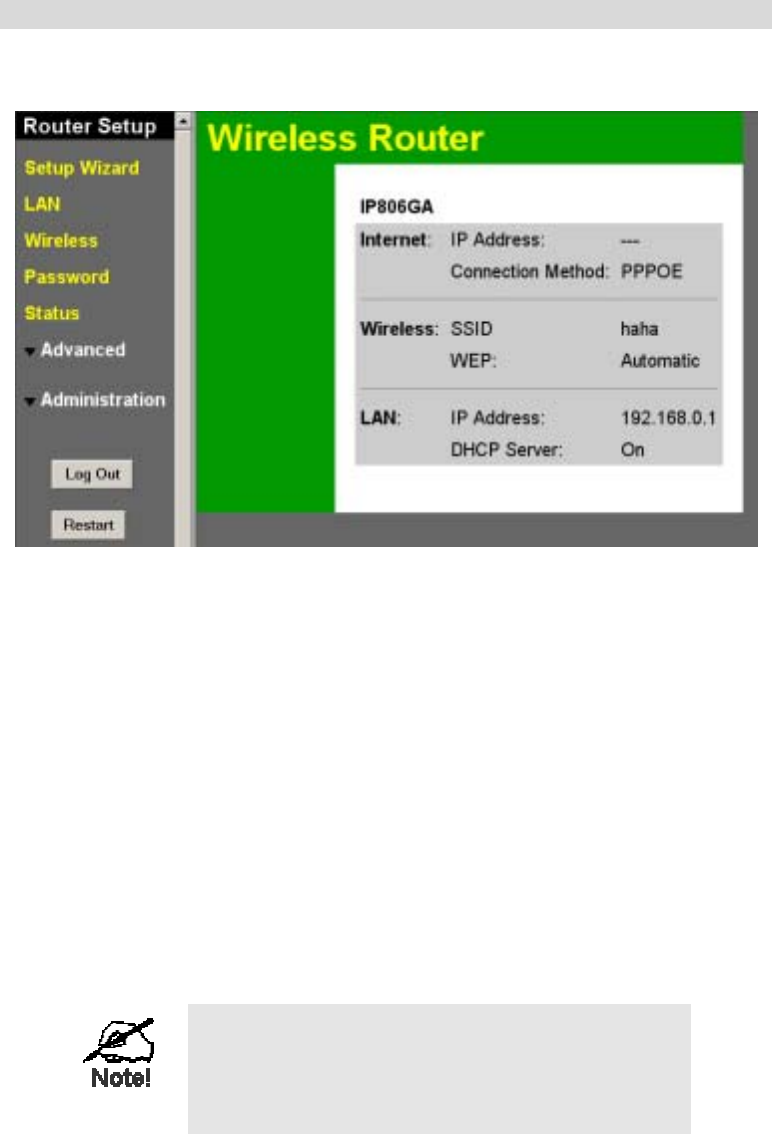
Wireless ADSL Router User Guide
12
Home Screen
After finishing the Setup Wizard, you will see the Home screen. When you connect in future,
you will see this screen when you connect. An example screen is shown below.
Figure 5: Home Screen
Main Menu
The main menu, on the left, contains links to the most-commonly used screen. To see the links
to the other available screens, click "Advanced" or "Administration".
The main menu also contains two (2) buttons:
• Log Out - When finished, you should click this button to logout.
• Restart - Use this if you wish to restart the Wireless ADSL Router. Note that restarting the
Router will break any existing connections to or through the Router.
Navigation & Data Input
• Use the menu bar on the left of the screen, and the "Back" button on your Browser, for
navigation.
• Changing to another screen without clicking "Save" does NOT save any changes you may
have made. You must "Save" before changing screens or your data will be ignored.
On each screen, clicking the "Help" button will
display help for that screen.
From any help screen, you can access the list of all
help files (help index).
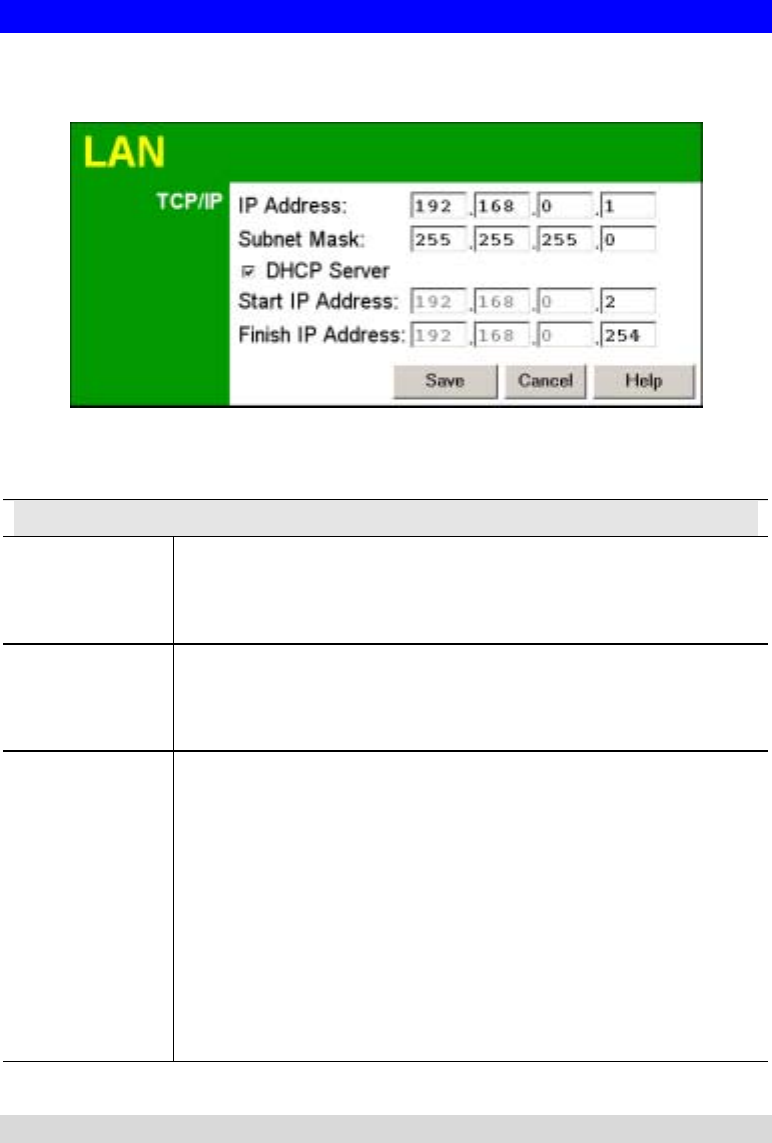
Setup
13
LAN Screen
Use the LAN link on the main menu to reach the LAN screen An example screen is shown
below.
Figure 6: LAN Screen
Data - LAN Screen
TCP/IP
IP Address IP address for the Wireless ADSL Router, as seen from the local LAN.
Use the default value unless the address is already in use or your LAN
is using a different IP address range. In the latter case, enter an unused
IP Address from within the range used by your LAN.
Subnet Mask The default value 255.255.255.0 is standard for small (class "C")
networks. For other networks, use the Subnet Mask for the LAN
segment to which the Wireless ADSL Router is attached (the same
value as the PCs on that LAN segment).
DHCP Server • If Enabled, the Wireless ADSL Router will allocate IP Addresses
to PCs (DHCP clients) on your LAN when they start up. The
default (and recommended) value is Enabled.
• If you are already using a DHCP Server, this setting must be
Disabled, and the existing DHCP server must be re-configured to
treat the Wireless ADSL Router as the default Gateway. See the
following section for further details.
• The Start IP Address and Finish IP Address fields set the values
used by the DHCP server when allocating IP Addresses to DHCP
clients. This range also determines the number of DHCP clients
supported.
See the following section for further details on using DHCP.
DHCP
What DHCP Does
A DHCP (Dynamic Host Configuration Protocol) Server allocates a valid IP address to a
DHCP Client (PC or device) upon request.
• The client request is made when the client device starts up (boots).

Wireless ADSL Router User Guide
14
• The DHCP Server provides the Gateway and DNS addresses to the client, as well as
allocating an IP Address.
• The Wireless ADSL Router can act as a DHCP server.
• Windows 95/98/ME and other non-Server versions of Windows will act as a DHCP client.
This is the default Windows setting for the TCP/IP network protocol. However, Windows
uses the term Obtain an IP Address automatically instead of "DHCP Client".
• You must NOT have two (2) or more DHCP Servers on the same LAN segment. (If your
LAN does not have other Routers, this means there must only be one (1) DHCP Server on
your LAN.)
Using the Wireless ADSL Router's DHCP Server
This is the default setting. The DHCP Server settings are on the LAN screen. On this screen,
you can:
• Enable or Disable the Wireless ADSL Router's DHCP Server function.
• Set the range of IP Addresses allocated to PCs by the DHCP Server function.
You can assign Fixed IP Addresses to some devices
while using DHCP, provided that the Fixed IP Addresses
are NOT within the range used by the DHCP Server.
Using another DHCP Server
You can only use one (1) DHCP Server per LAN segment. If you wish to use another DHCP
Server, rather than the Wireless ADSL Router's, the following procedure is required.
1. Disable the DHCP Server feature in the Wireless ADSL Router. This setting is on the
LAN screen.
2. Configure the DHCP Server to provide the Wireless ADSL Router's IP Address as the
Default Gateway.
To Configure your PCs to use DHCP
This is the default setting for TCP/IP for all non-Server versions of Windows.
See Chapter 4 - Client Configuration for the procedure to check these settings.
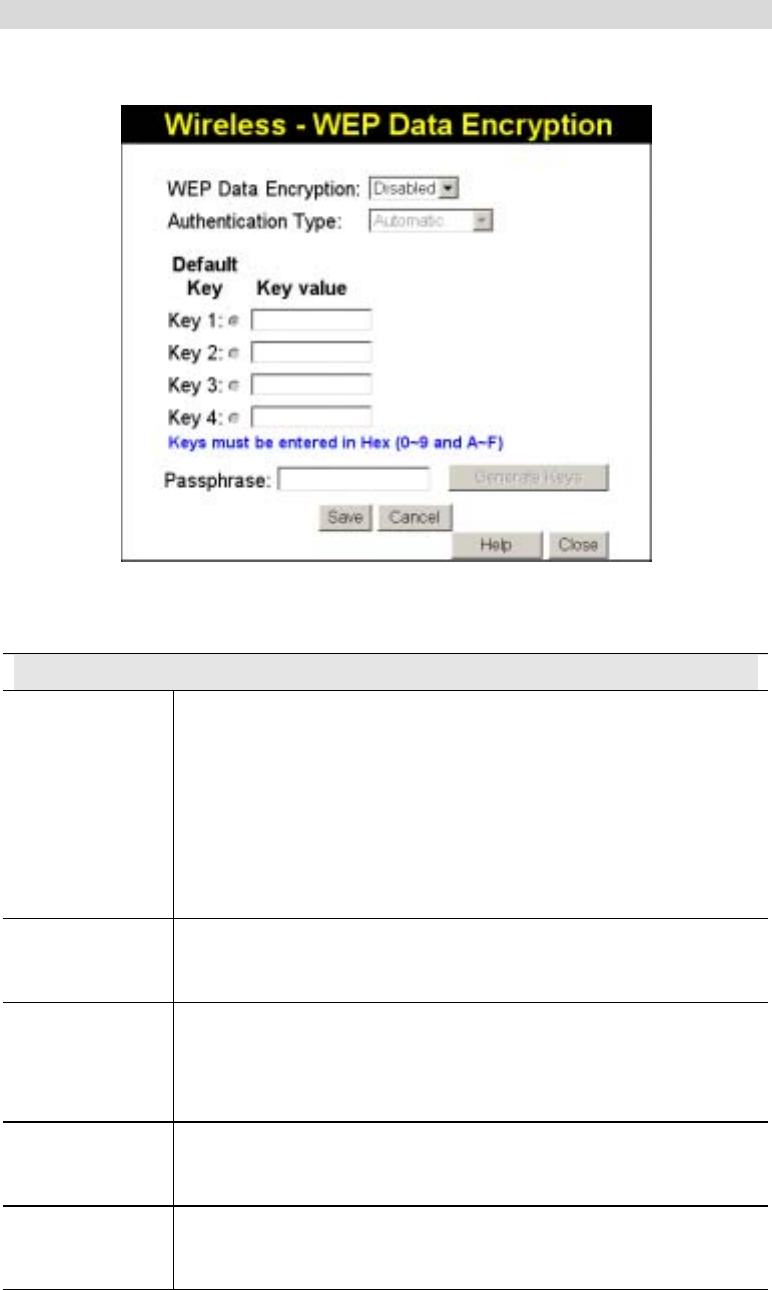
Wireless ADSL Router User Guide
15
WEP Screen
This screen is accessed by clicking the "Configure WEP" button on the Wireless screen.
Figure 8: WEP Screen
Data - WEP Screen
WEP Data Encryption
WEP Data
Encryption Select the option to match other Wireless Stations:
• Disabled - data is NOT encrypted before being transmitted.
• 64 Bit - data is encrypted, using the default key, before being
transmitted. You must enter at least the default key. For 64 Bit
Encryption, the key size is 10 chars in HEX (0~9 and A~F).
• 128 Bit - data is encrypted, using the default key, before being
transmitted. You must enter at least the default key. For 128 Bit
Encryption, the key size is 26 chars in HEX (0~9 and A~F).
Authentication
Type Normally, this should be left at the default value of "Automatic". If
changed to "Open System" or "Shared Key", ensure that your Wireless
Stations use the same setting.
Default Key Select the key you wish to be the default. Transmitted data is
ALWAYS encrypted using the Default Key; the other Keys are for
decryption only.
You must enter a Key Value for the Default Key.
Key Value Enter the key value or values you wish to use. The Default Key is
required, the other keys are optional. Other stations must have the
same key.
Passphrase If desired, you can generate a key from a phrase, instead of entering
the key value directly. Enter the desired phrase, and click the
"Generate Keys" button.

Setup
16
Password Screen
The password screen allows you to assign a password to the Wireless ADSL Router.
Figure 9: Password Screen
Once you have assigned a password to the Wireless ADSL Router (on the Password screen
above) you will be prompted for the password when you connect, as shown below. (If no
password has been set, this dialog will not appear.)
Figure 10: Password Dialog
• Leave the "User Name" blank.
• Enter the password for the Wireless ADSL Router, as set on the Password screen above.

17
Chapter 4
PC Configuration
This Chapter details the PC Configuration required on the local ("Internal")
LAN.
Overview
For each PC, the following may need to be configured:
• TCP/IP network settings
• Internet Access configuration
• Wireless configuration
Windows Clients
This section describes how to configure Windows clients for Internet access via the Wireless
ADSL Router.
The first step is to check the PC's TCP/IP settings.
The Wireless ADSL Router uses the TCP/IP network protocol for all functions, so it is
essential that the TCP/IP protocol be installed and configured on each PC.
TCP/IP Settings - Overview
If using the default Wireless ADSL Router settings, and the default
Windows TCP/IP settings, no changes need to be made.
• By default, the Wireless ADSL Router will act as a DHCP Server, automatically providing
a suitable IP Address (and related information) to each PC when the PC boots.
• For all non-Server versions of Windows, the default TCP/IP setting is to act as a DHCP
client.
If using a Fixed (specified) IP address, the following changes are
required:
• The Gateway must be set to the IP address of the Wireless ADSL Router
• The DNS should be set to the address provided by your ISP.
If your LAN has a Router, the LAN Administrator must re-
configure the Router itself. Refer to Chapter 8 -
Advanced Setup for details.
4
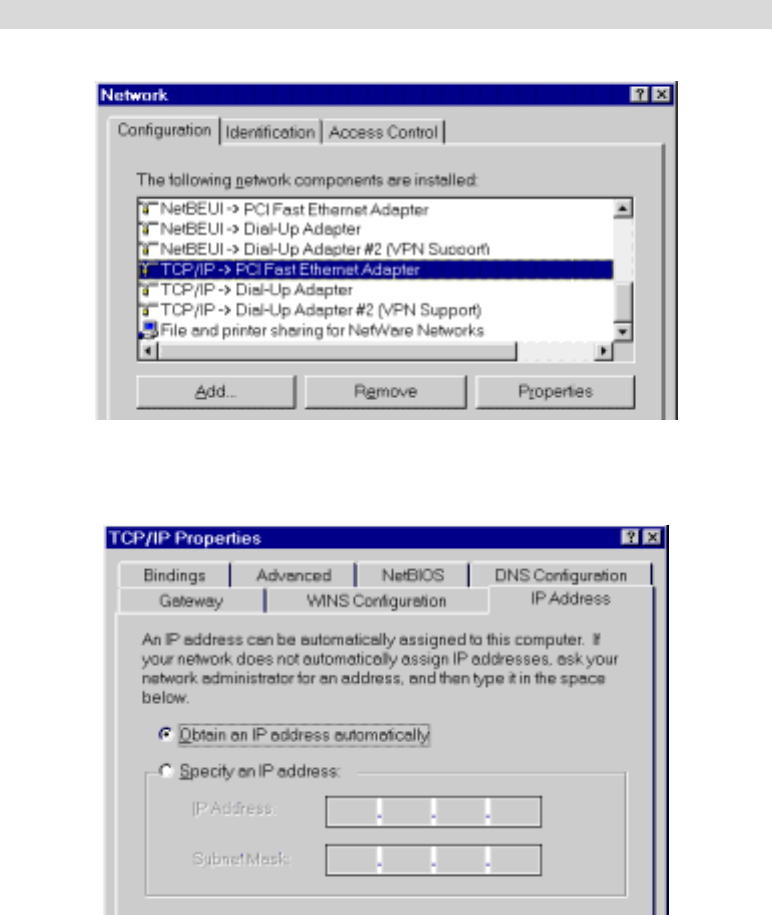
PC Configuration
18
Checking TCP/IP Settings - Windows 9x/ME:
1. Select Control Panel - Network. You should see a screen like the following:
Figure 11: Network Configuration
2. Select the TCP/IP protocol for your network card.
3. Click on the Properties button. You should then see a screen like the following.
Figure 12: IP Address (Win 95)
Ensure your TCP/IP settings are correct, as follows:
Using DHCP
To use DHCP, select the radio button Obtain an IP Address automatically. This is the default
Windows setting. Using this is recommended. By default, the Wireless ADSL Router will act
as a DHCP Server.
Restart your PC to ensure it obtains an IP Address from the Wireless ADSL Router.
Using "Specify an IP Address"
If your PC is already configured, check with your network administrator before making the
following changes:
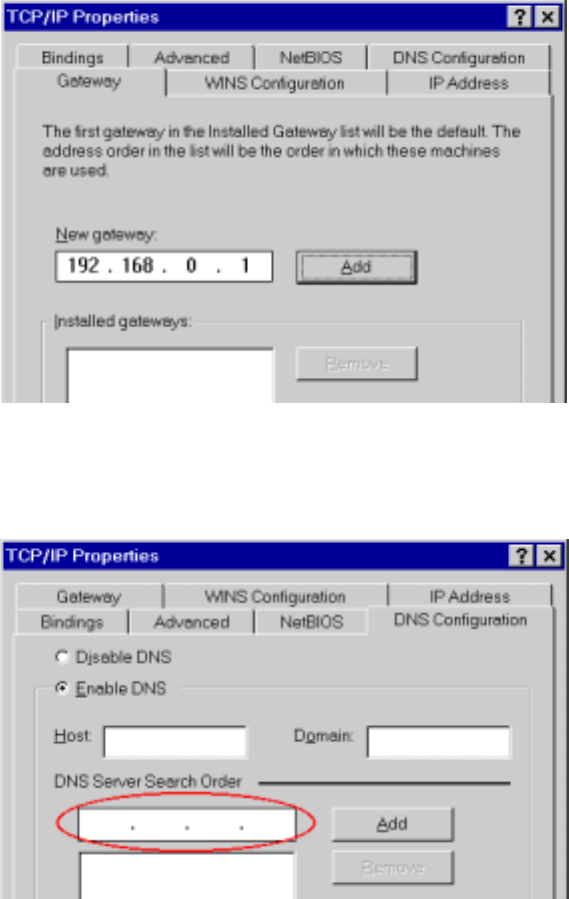
Wireless ADSL Router User Guide
19
• On the Gateway tab, enter the Wireless ADSL Router's IP address in the New Gateway
field and click Add, as shown below. Your LAN administrator can advise you of the IP
Address they assigned to the Wireless ADSL Router.
Figure 13: Gateway Tab (Win 95/98)
• On the DNS Configuration tab, ensure Enable DNS is selected. If the DNS Server Search
Order list is empty, enter the DNS address provided by your ISP in the fields beside the
Add button, then click Add.
Figure 14: DNS Tab (Win 95/98)
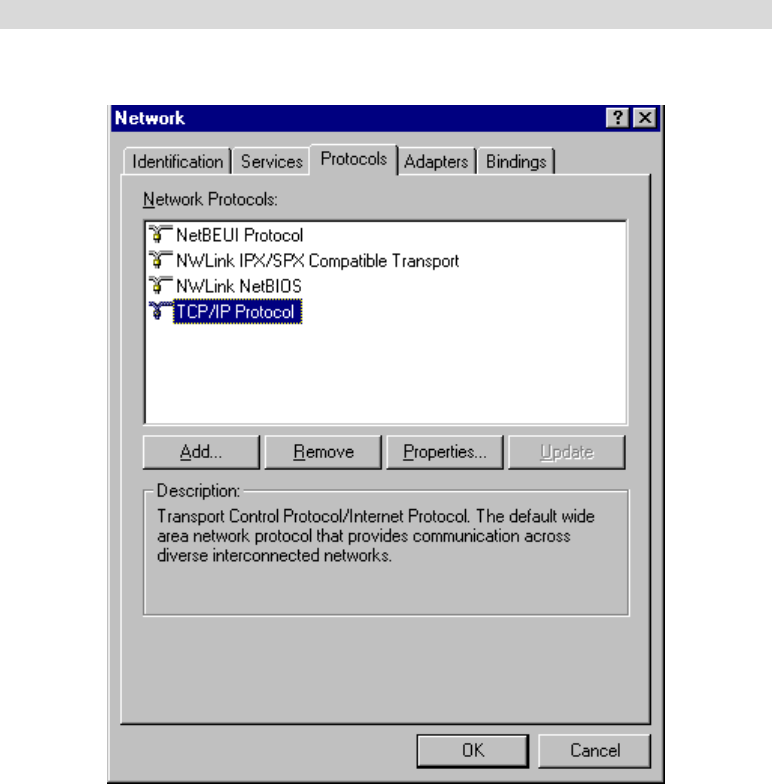
PC Configuration
20
Checking TCP/IP Settings - Windows NT4.0
1. Select Control Panel - Network, and, on the Protocols tab, select the TCP/IP protocol, as
shown below.
Figure 15: Windows NT4.0 - TCP/IP
2. Click the Properties button to see a screen like the one below.
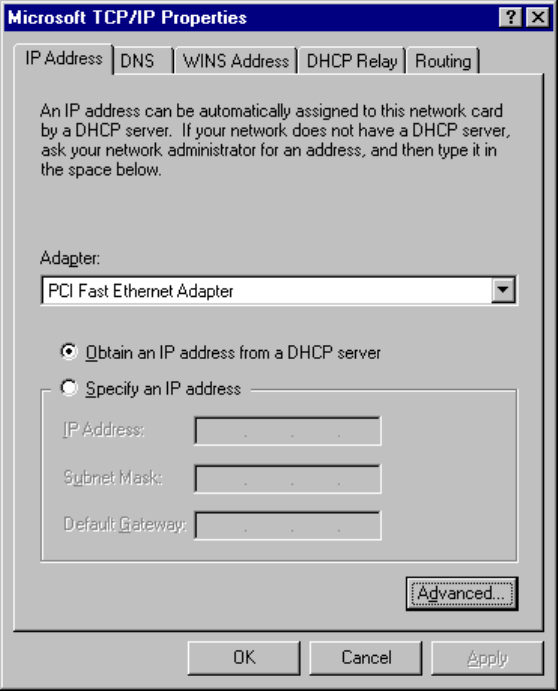
Wireless ADSL Router User Guide
21
Figure 16: Windows NT4.0 - IP Address
3. Select the network card for your LAN.
4. Select the appropriate radio button - Obtain an IP address from a DHCP Server or Specify
an IP Address, as explained below.
Obtain an IP address from a DHCP Server
This is the default Windows setting. Using this is recommended. By default, the Wireless
ADSL Router will act as a DHCP Server.
Restart your PC to ensure it obtains an IP Address from the Wireless ADSL Router.
Specify an IP Address
If your PC is already configured, check with your network administrator before making the
following changes.
1. The Default Gateway must be set to the IP address of the Wireless ADSL Router. To set
this:
• Click the Advanced button on the screen above.
• On the following screen, click the Add button in the Gateways panel, and enter the
Wireless ADSL Router's IP address, as shown in Figure 17 below.
• If necessary, use the Up button to make the Wireless ADSL Router the first entry in
the Gateways list.
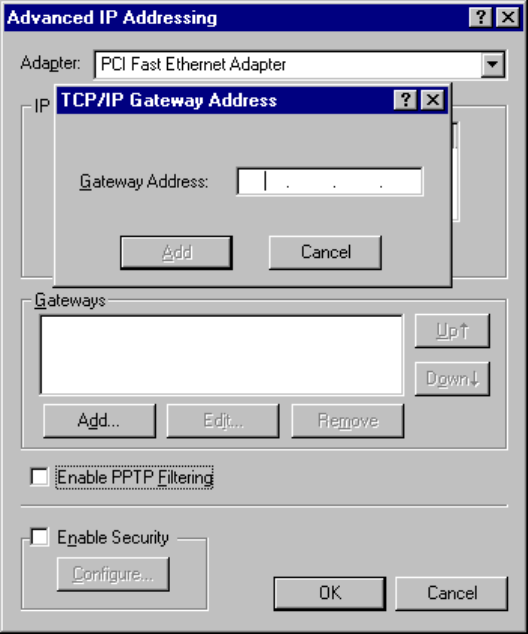
PC Configuration
22
Figure 17 - Windows NT4.0 - Add Gateway
2. The DNS should be set to the address provided by your ISP, as follows:
• Click the DNS tab.
• On the DNS screen, shown below, click the Add button (under DNS Service Search
Order), and enter the DNS provided by your ISP.
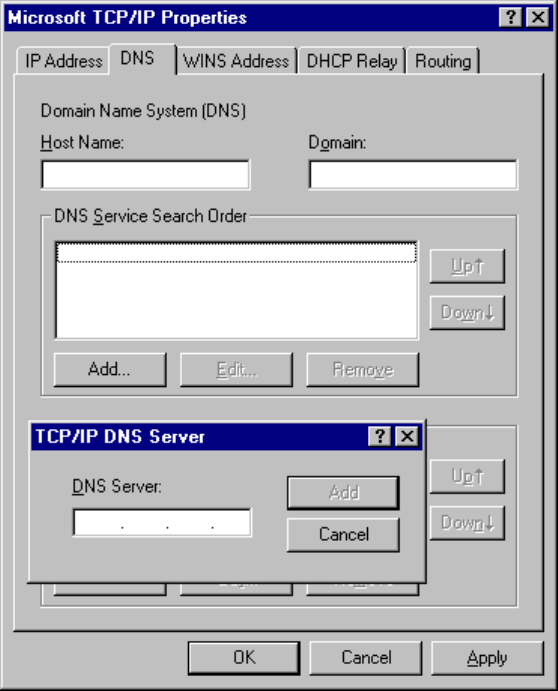
Wireless ADSL Router User Guide
23
Figure 18: Windows NT4.0 - DNS
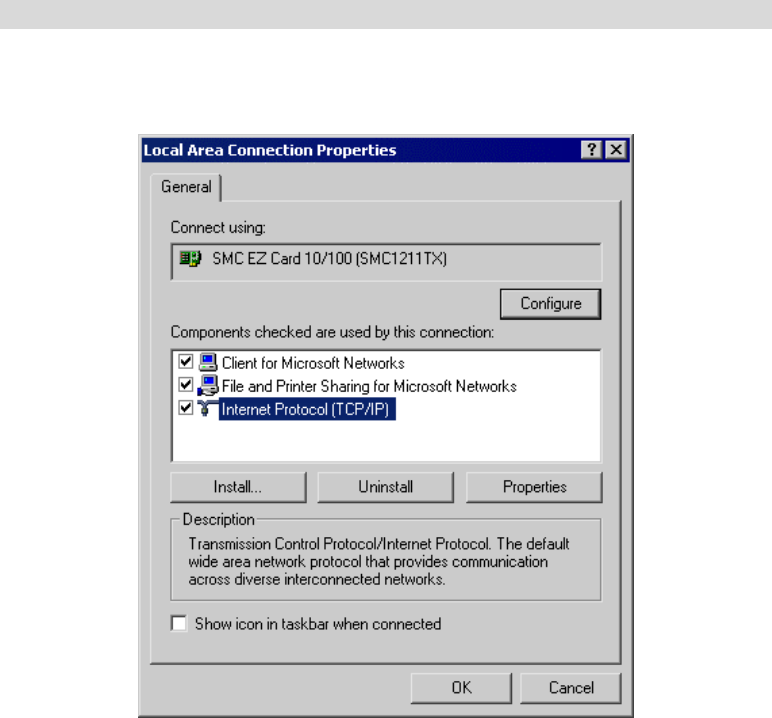
PC Configuration
24
Checking TCP/IP Settings - Windows 2000:
1. Select Control Panel - Network and Dial-up Connection.
2. Right - click the Local Area Connection icon and select Properties. You should see a
screen like the following:
Figure 19: Network Configuration (Win 2000)
3. Select the TCP/IP protocol for your network card.
4. Click on the Properties button. You should then see a screen like the following.
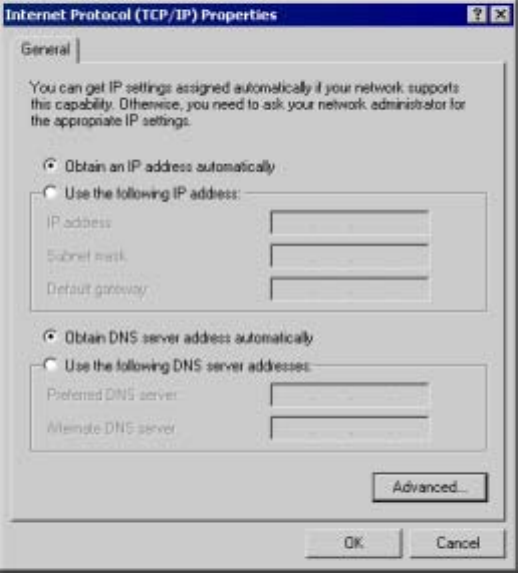
Wireless ADSL Router User Guide
25
Figure 20: TCP/IP Properties (Win 2000)
5. Ensure your TCP/IP settings are correct, as described below.
Using DHCP
To use DHCP, select the radio button Obtain an IP Address automatically. This is the default
Windows setting. Using this is recommended. By default, the Wireless ADSL Router will act
as a DHCP Server.
Restart your PC to ensure it obtains an IP Address from the Wireless ADSL Router.
Using a fixed IP Address ("Use the following IP Address")
If your PC is already configured, check with your network administrator before making the
following changes.
• Enter the Wireless ADSL Router's IP address in the Default gateway field and click OK.
(Your LAN administrator can advise you of the IP Address they assigned to the Wireless
ADSL Router.)
• If the DNS Server fields are empty, select Use the following DNS server addresses, and
enter the DNS address or addresses provided by your ISP, then click OK.
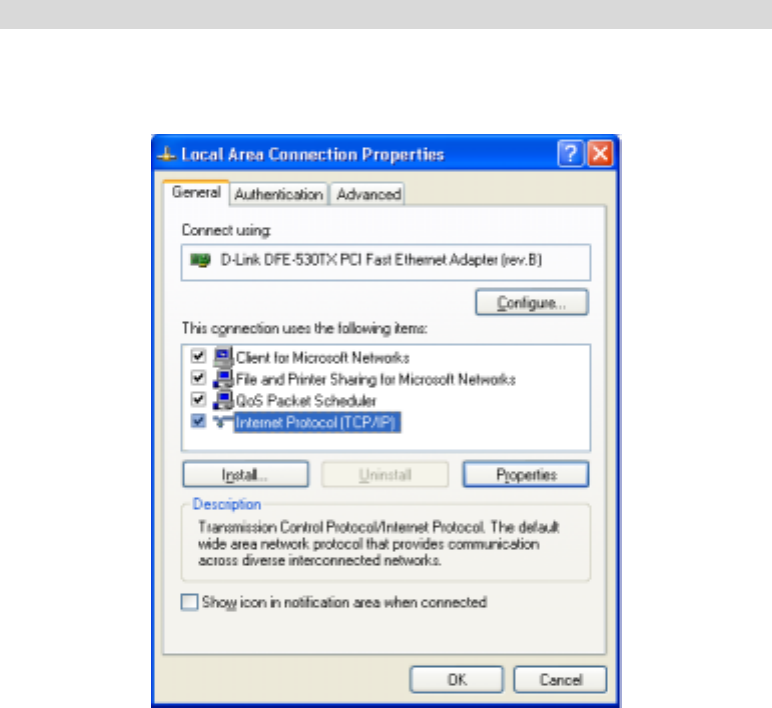
PC Configuration
26
Checking TCP/IP Settings - Windows XP
1. Select Control Panel - Network Connection.
2. Right click the Local Area Connection and choose Properties. You should see a screen
like the following:
Figure 21: Network Configuration (Windows XP)
3. Select the TCP/IP protocol for your network card.
4. Click on the Properties button. You should then see a screen like the following.
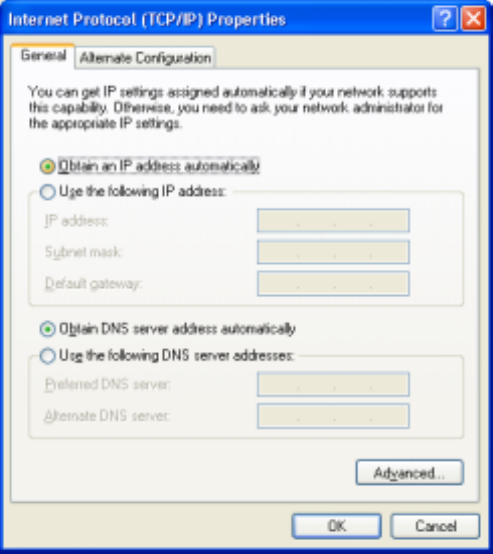
Wireless ADSL Router User Guide
27
Figure 22: TCP/IP Properties (Windows XP)
5. Ensure your TCP/IP settings are correct.
Using DHCP
To use DHCP, select the radio button Obtain an IP Address automatically. This is the default
Windows setting. Using this is recommended. By default, the Wireless ADSL Router will act
as a DHCP Server.
Restart your PC to ensure it obtains an IP Address from the Wireless ADSL Router.
Using a fixed IP Address ("Use the following IP Address")
If your PC is already configured, check with your network administrator before making the
following changes.
• In the Default gateway field, enter the Wireless ADSL Router's IP address and click OK.
Your LAN administrator can advise you of the IP Address they assigned to the Wireless
ADSL Router.
• If the DNS Server fields are empty, select Use the following DNS server addresses, and
enter the DNS address or addresses provided by your ISP, then click OK.

PC Configuration
28
Internet Access
To configure your PCs to use the Wireless ADSL Router for Internet access:
• Ensure that the DSL modem, Cable modem, or other permanent connection is functional.
• Use the following procedure to configure your Browser to access the Internet via the LAN,
rather than by a Dial-up connection.
For Windows 9x/ME/2000
1. Select Start Menu - Settings - Control Panel - Internet Options.
2. Select the Connection tab, and click the Setup button.
3. Select "I want to set up my Internet connection manually, or I want to connect through a
local area network (LAN)" and click Next.
4. Select "I connect through a local area network (LAN)" and click Next.
5. Ensure all of the boxes on the following Local area network Internet Configuration screen
are unchecked.
6. Check the "No" option when prompted "Do you want to set up an Internet mail account
now?".
7. Click Finish to close the Internet Connection Wizard.
Setup is now completed.
For Windows XP
1. Select Start Menu - Control Panel - Network and Internet Connections.
2. Select Set up or change your Internet Connection.
3. Select the Connection tab, and click the Setup button.
4. Cancel the pop-up "Location Information" screen.
5. Click Next on the "New Connection Wizard" screen.
6. Select "Connect to the Internet" and click Next.
7. Select "Set up my connection manually" and click Next.
8. Check "Connect using a broadband connection that is always on" and click Next.
9. Click Finish to close the New Connection Wizard.
Setup is now completed.
Accessing AOL
To access AOL (America On Line) through the Wireless ADSL Router, the AOL for Windows
software must be configured to use TCP/IP network access, rather than a dial-up connection.
The configuration process is as follows:
• Start the AOL for Windows communication software. Ensure that it is Version 2.5, 3.0 or
later. This procedure will not work with earlier versions.
• Click the Setup button.
• Select Create Location, and change the location name from "New Locality" to "Wireless
ADSL Router".
• Click Edit Location. Select TCP/IP for the Network field. (Leave the Phone Number
blank.)
• Click Save, then OK.
Configuration is now complete.
• Before clicking "Sign On", always ensure that you are using the "Wireless ADSL Router"
location.

Wireless ADSL Router User Guide
29
Macintosh Clients
From your Macintosh, you can access the Internet via the Wireless ADSL Router. The
procedure is as follows.
1. Open the TCP/IP Control Panel.
2. Select Ethernet from the Connect via pop-up menu.
3. Select Using DHCP Server from the Configure pop-up menu. The DHCP Client ID field
can be left blank.
4. Close the TCP/IP panel, saving your settings.
Note:
If using manually assigned IP addresses instead of DHCP, the required changes are:
• Set the Router Address field to the Wireless ADSL Router's IP Address.
• Ensure your DNS settings are correct.
Linux Clients
To access the Internet via the Wireless ADSL Router, it is only necessary to set the Wireless
ADSL Router as the "Gateway".
Ensure you are logged in as "root" before attempting any changes.
Fixed IP Address
By default, most Unix installations use a fixed IP Address. If you wish to continue using a
fixed IP Address, make the following changes to your configuration.
• Set your "Default Gateway" to the IP Address of the Wireless ADSL Router.
• Ensure your DNS (Name server) settings are correct.
To act as a DHCP Client (recommended)
The procedure below may vary according to your version of Linux and X -windows shell.
1. Start your X Windows client.
2. Select Control Panel - Network
3. Select the "Interface" entry for your Network card. Normally, this will be called "eth0".
4. Click the Edit button, set the "protocol" to "DHCP", and save this data.
5. To apply your changes
• Use the "Deactivate" and "Activate" buttons, if available.
• OR, restart your system.
Other Unix Systems
To access the Internet via the Wireless ADSL Router:
• Ensure the "Gateway" field for your network card is set to the IP Address of the Wireless
ADSL Router.
• Ensure your DNS (Name Server) settings are correct.

PC Configuration
30
Wireless Station Configuration
This section applies to all Wireless stations wishing to use the Wireless ADSL Router's Access
Point, regardless of the operating system which is used on the client.
To use the Wireless Access Point in the Wireless ADSL Router, each Wireless Station must
have compatible settings, as follows:
Mode The mode must be set to Infrastructure (rather than Ad-hoc)
Access points only operate in to Infrastructure mode.
SSID (ESSID) This must match the value used on the Wireless ADSL Router. The
default value is default
Note! The SSID is case sensitive.
WEP By default, WEP on the Wireless ADSL Router is disabled.
• If WEP remains disabled on the Wireless ADSL Router, all stations
must have WEP disabled.
• If WEP is enabled on the Wireless ADSL Router, each station must
use the same settings as the Wireless ADSL Router.
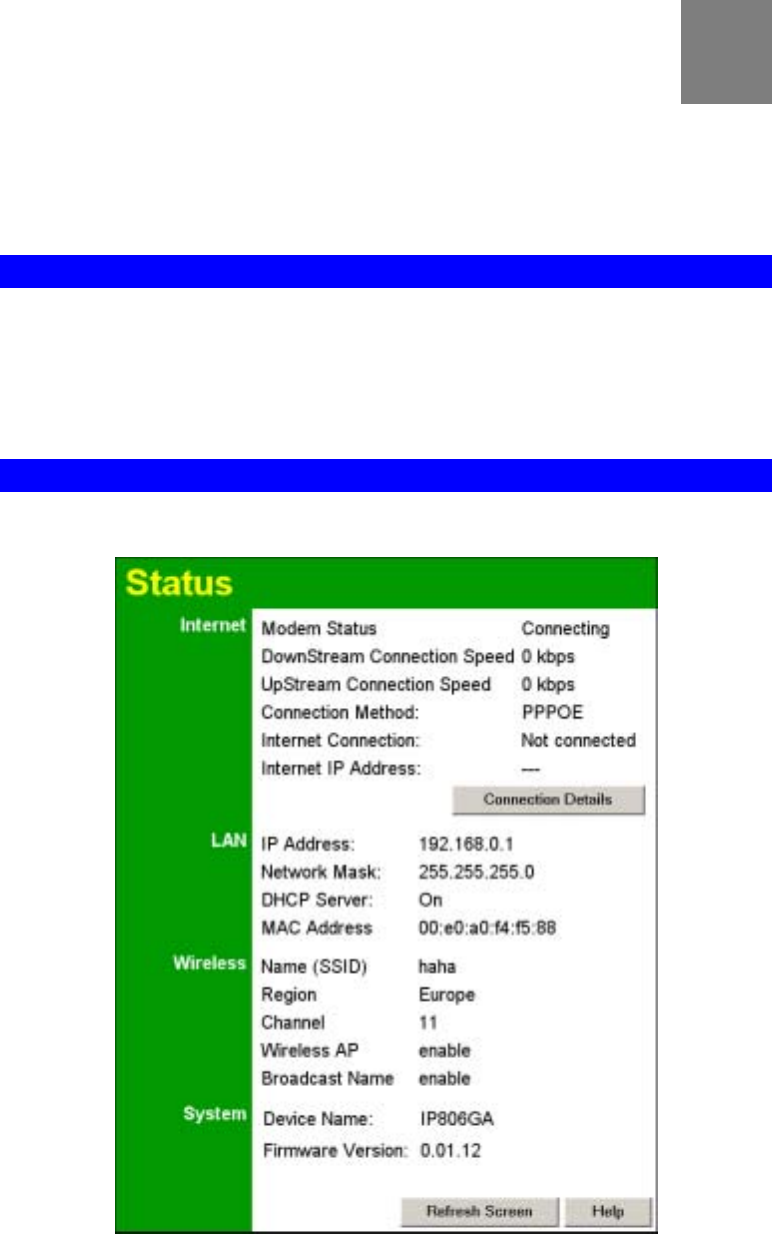
31
Chapter 5
Operation and Status
This Chapter details the operation of the Wireless ADSL Router and the
status screens.
Operation
Once both the Wireless ADSL Router and the PCs are configured, operation is automatic.
However, there are some situations where additional Internet configuration may be required.
Refer to Chapter 6 - Advanced Features for further details.
Status Screen
Use the Status link on the main menu to view this screen.
Figure 23: Status Screen
5

Operation and Status
32
Data - Status Screen
Internet
Modem Status This indicates the status of the ADSL modem component.
DownStream
Connection Speed If connected, displays the speed for the DownStream (download)
ADSL Connection.
UpStream
Connection Method If connected, displays the speed for the UpStream (upload) ADSL
Connection.
Connection Method This indicates the current connection method, as set in the Setup
Wizard.
Internet Connection This indicates the current status of the Internet Connection
• Active - Connection exists
• Not connected - No current connection, but no error has
been detected. This condition normally arises when an idle
connection is automatically terminated.
• Failed - The connection was terminated abnormally. This
could be caused by ADSL failure, Router failure, or
termination of the connection by your ISP.
If there is an error, you can click the "Connection Details" button
to find out more information.
Internet IP Address This IP Address is allocated by the ISP (Internet Service
Provider). If using a dynamic IP address, and no connection
currently exists, this information is unavailable.
LAN
IP Address The IP Address of the Wireless ADSL Router.
Network Mask The Network Mask (Subnet Mask) for the IP Address above.
DHCP Server This shows the status of the DHCP Server function. The value
will be "Enabled" or "Disabled".
MAC Address This shows the MAC Address for the Wireless ADSL Router, as
seen on the LAN interface.
Wireless
Name (SSID) If using an ESS (Extended Service Set, with multiple access
points) this ID is called an ESSID (Extended Service Set
Identifier).
Region The current region, as set on the Wireless screen.
Channel This shows the Channel currently used, as set on the Wireless
screen.
Wireless AP This indicates whether or not the Wireless Access Point feature is
enabled.
Broadcast Name This indicates whether or not the SSID is Broadcast. This setting
is on the Wireless screen.
System
Device Name The current name of the Wireless ADSL Router. This is also the
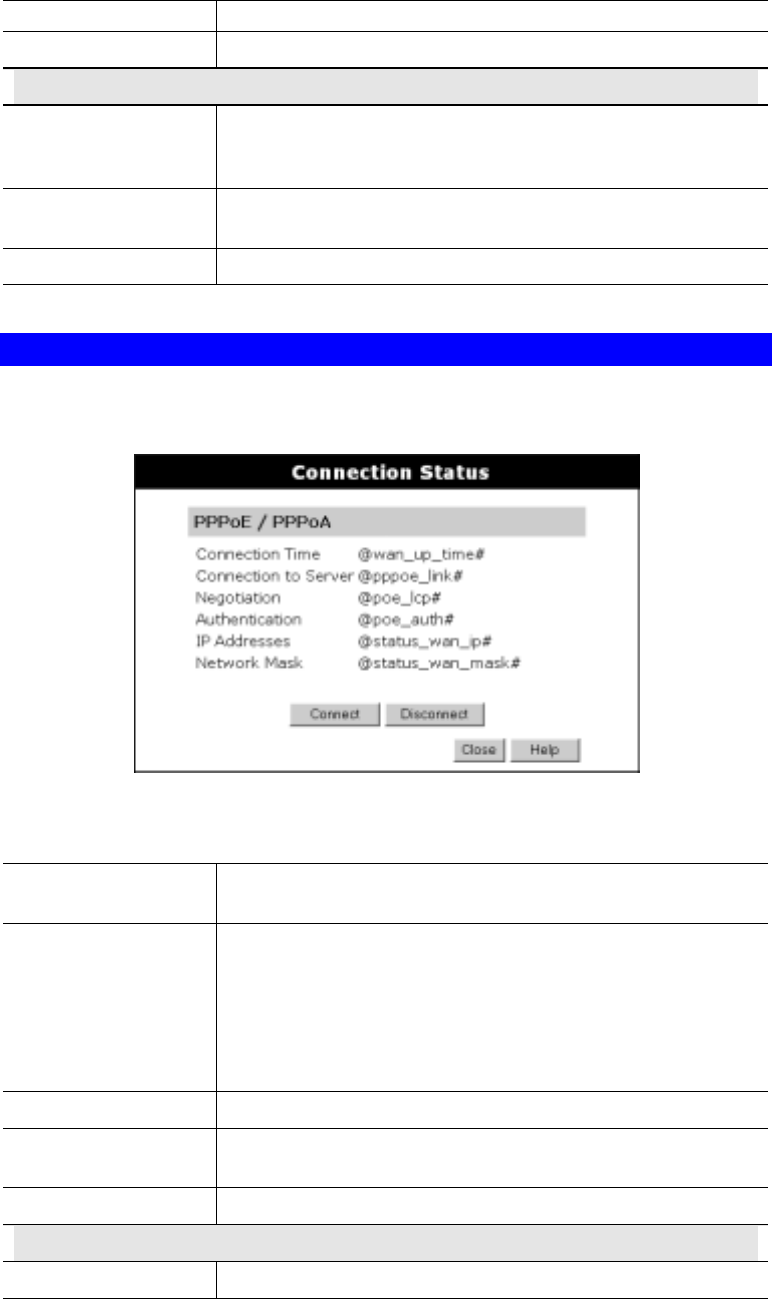
Wireless ADSL Router User Guide
33
"hostname" provided to ISPs who request this information.
Firmware Version The version of the current firmware installed.
Buttons
Connection Details Click this button to open a sub-window and view a detailed
description of the current connection. Depending on the type of
connection, a "log" may also be available.
Attached Devices This will open a sub-window, showing all LAN and Wireless
devices currently on the network.
Refresh Screen Update the data displayed on screen.
Connection Status - PPPoE & PPPoA
If using PPPoE (PPP over Ethernet) or PPPoA (PPP over ATM), a screen like the following
example will be displayed when the "Connection Details" button is clicked.
Figure 24: PPPoE Status Screen
Data - PPPoE Screen
Connection Time This indicates how long the current connection has been
established.
PPPoE Link Status This indicates whether or not the connection is currently
established.
• If the connection does not exist, the "Connect" button can be
used to establish a connection.
• If the connection currently exists, the "Disconnect" button
can be used to break the connection.
Negotiation This indicates the status of the PPPoE Server login.
IP Address The IP Address of this device, as seen by Internet users. This
address is allocated by your ISP (Internet Service Provider).
Network Mask The Network Mask associated with the IP Address above.
Buttons
Connect If not connected, establish a connection to your ISP.
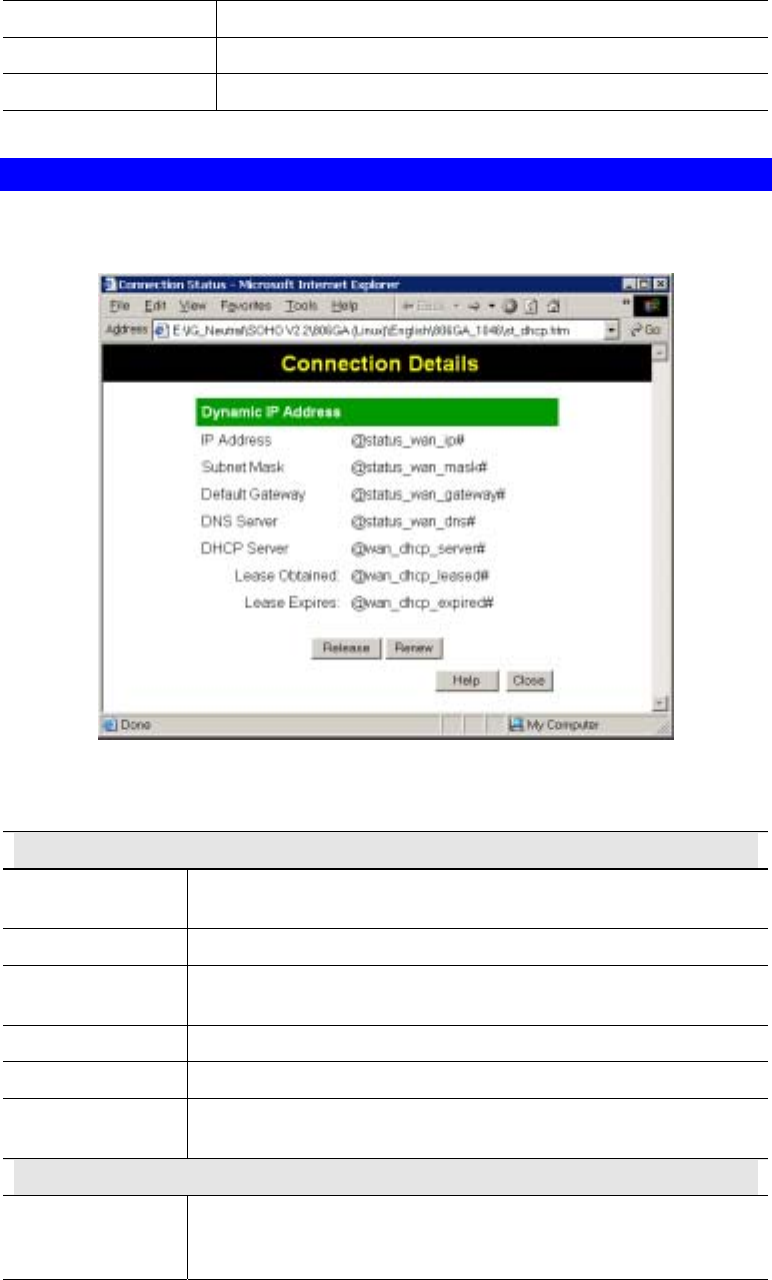
Operation and Status
34
Disconnect If connected to your ISP, hang up the connection.
Refresh Update the data on screen.
Close Close this window.
Connection Details - Dynamic IP Address
If your access method is "Direct" (no login), with a Dynamic IP address, a screen like the
following example will be displayed when the "Connection Details" button is clicked.
Figure 25: Connection Details - Fixed/Dynamic IP Address
Data - Dynamic IP address
Internet
IP Address The current IP Address of this device, as seen by Internet users. This
address is allocated by your ISP (Internet Service Provider).
Network Mask The Network Mask associated with the IP Address above.
Default Gateway The IP address of the remote Gateway or Router associated with the
IP Address above.
DNS Server The IP address of the Domain Name Server which is currently used.
DHCP Server The IP address of your ISP's DHCP Server.
Lease Obtained
Lease Expires This indicates when the current IP address was obtained, and how
long before this IP address allocation (the DCHP lease) expires.
Buttons
Release If an IP Address has been allocated to the Wireless ADSL Router (by
the ISP's DHCP Server, clicking the "Release" button will break the
connection and release the IP Address.

Wireless ADSL Router User Guide
35
Renew If the ISP's DHCP Server has NOT allocated an IP Address for the
Wireless ADSL Router, clicking the "Renew" button will attempt to
re-establish the connection and obtain an IP Address from the ISP's
DHCP Server.
Refresh Update the data shown on screen.
Close Close this window.
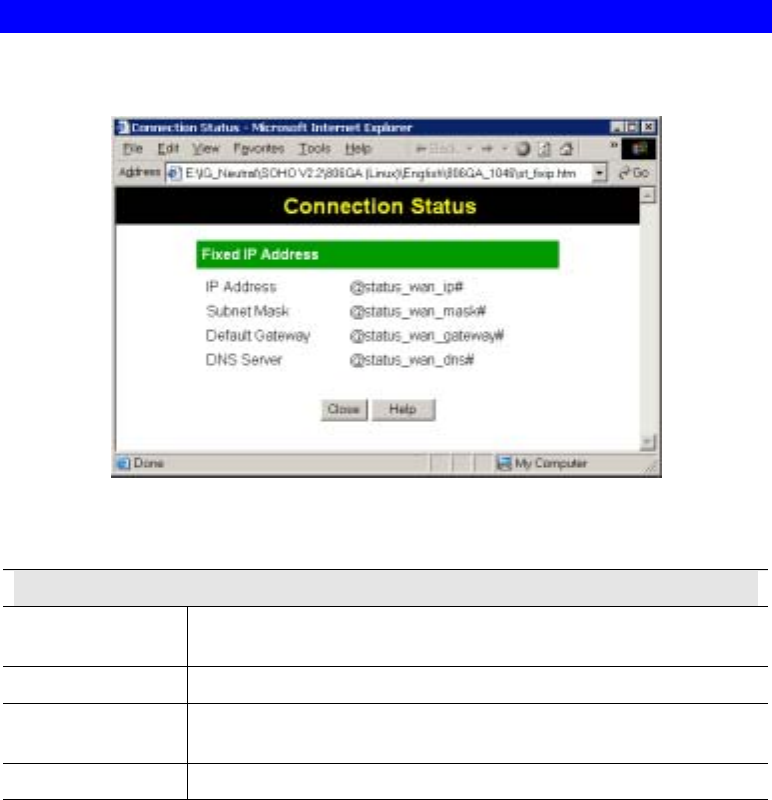
Operation and Status
36
Connection Details - Fixed IP Address
If your access method is "Direct" (no login), with a fixed IP address, a screen like the
following example will be displayed when the "Connection Details" button is clicked.
Figure 26: Connection Details - Fixed/Dynamic IP Address
Data - Fixed IP address Screen
Internet
IP Address The IP Address of this device, as seen by Internet users. This address
is allocated by your ISP (Internet Service Provider).
Network Mask The Network Mask associated with the IP Address above.
Default Gateway The IP Address of the remote Gateway or Router associated with the
IP Address above.
DNS Server The IP Address of the Domain Name Server which is currently used.

37
Chapter 6
Advanced Features
This Chapter explains when and how to use the Wireless ADSL Router's
"Advanced" Features.
Overview
The following advanced features are provided:
• Dynamic DNS
• Firewall Rules and Services
• Scheduling
• URL filter
• Virtual Servers
Dynamic DNS (Domain Name Server)
This free service is very useful when combined with the Virtual Server feature. It allows
Internet users to connect to your Virtual Servers using a URL, rather than an IP Address.
This also solves the problem of having a dynamic IP address. With a dynamic IP address, your
IP address may change whenever you connect, which makes it difficult to connect to you.
The DynDNS Service works as follows:
1. You must register for the service at http://www.dyndns.org (Registration is free). Your
password will be E-mailed to you.
2. After registration, use the "Create New Host" option (at www.dyndns.org) to request your
desired Domain name.
3. Enter your data from www.dyndns.org in the Wireless ADSL Router's DDNS screen.
4. The Wireless ADSL Router will then automatically ensure that your current IP Address is
recorded at http://www.dyndns.org
5. From the Internet, users will be able to connect to your Virtual Servers (or DMZ PC)
using your Domain name, as shown on this screen.
6
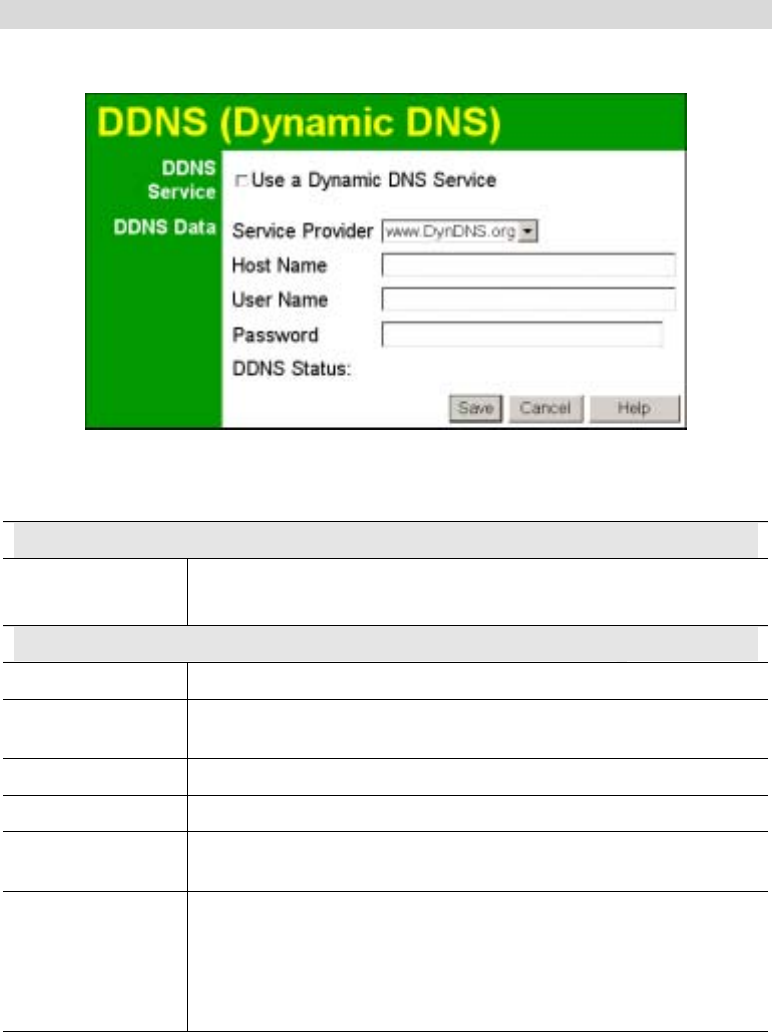
Advanced Features
38
Dynamic DNS Screen
Select Advanced on the main menu, then Dynamic DNS, to see a screen like the following:
Figure 27: DDNS Screen
Data - Dynamic DNS Screen
DDNS Service
Use a Dynamic
DNS Service
Use this to enable or disable the DDNS feature as required.
DDNS Data
Service Provider Select the desired DDNS Service provider.
Host Name Enter the domain name allocated to you by the DDNS Service. If you
have more than one name, enter the name you wish to use.
User Name Enter your Username for the DDNS Service.
Password Enter your current password for the DDNS Service.
Domain Name Enter the domain name allocated to you by the DDNS Service. If you
have more than one name, enter the name you wish to use.
DDNS Status • This message is returned by the DDNS Server
• Normally, this message should be "Update successful"
• If the message is "No host", this indicates the host name entered
was not allocated to you. You need to connect to DDNS Service
provider and correct this problem.
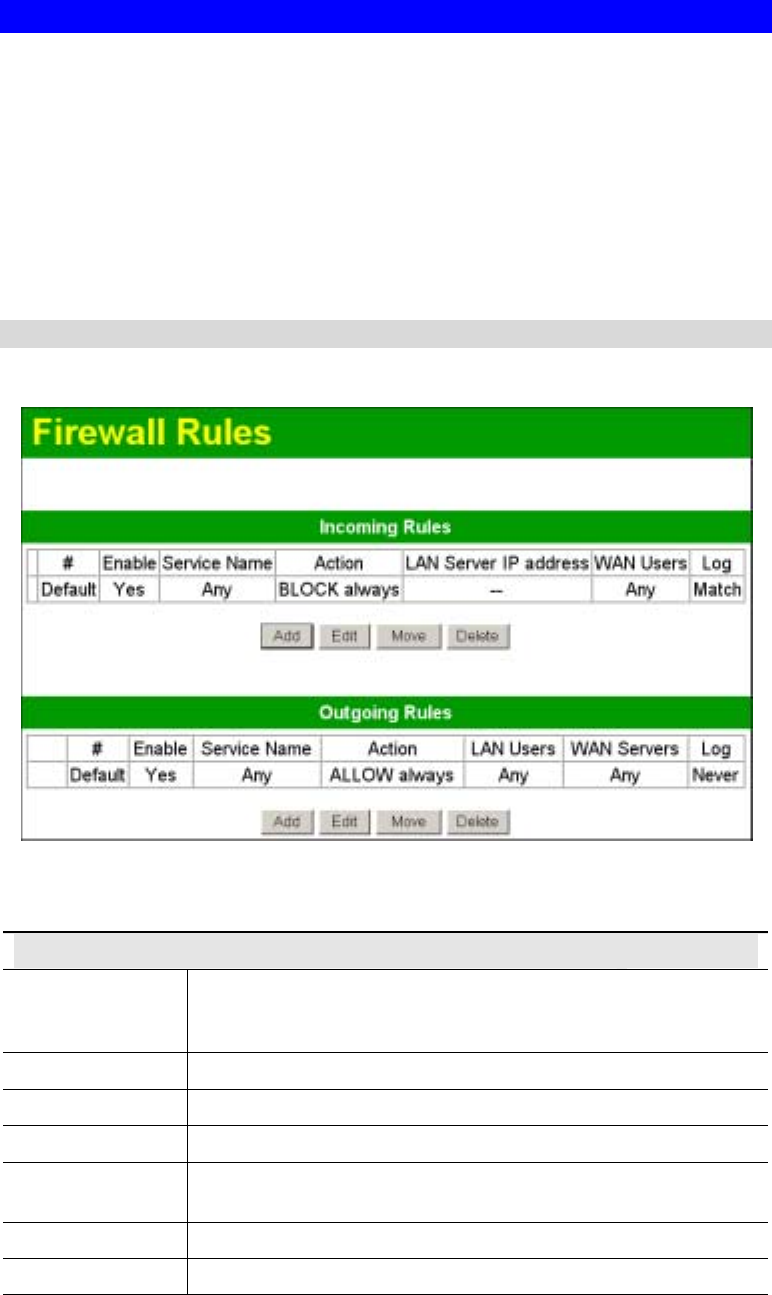
Wireless ADSL Router User Guide
39
Firewall Rules
The Firewall Rules screen allows you to define "Firewall Rules" which can allow or prevent
certain traffic.
By default:
• All Outgoing traffic is permitted.
• All Incoming traffic is denied.
"Traffic" means incoming connection attempts, not packets.
Because of this default behavior, any Outgoing rules will generally Block traffic, and
Incoming rules will generally Allow traffic.
Firewall Rules Screen
An example screen is shown below.
Figure 28 Firewall Screen
Data – Firewall Rules
Incoming Rules
# For the default rule, this will display "Default".
For other rules, this will display a radio button which allows you to
select the rule.
Enable Indicates whether or not the rule is currently enabled.
Service Name The Service covered by this rule.
Action The action performed on connections which are covered by this rule.
LAN Server The PC or Server on your LAN to which traffic covered by this rule
will be sent.
WAN Users The WAN IP address or addresses covered by this rule.
Log Indicates whether or not connections covered by this rule should be
ld
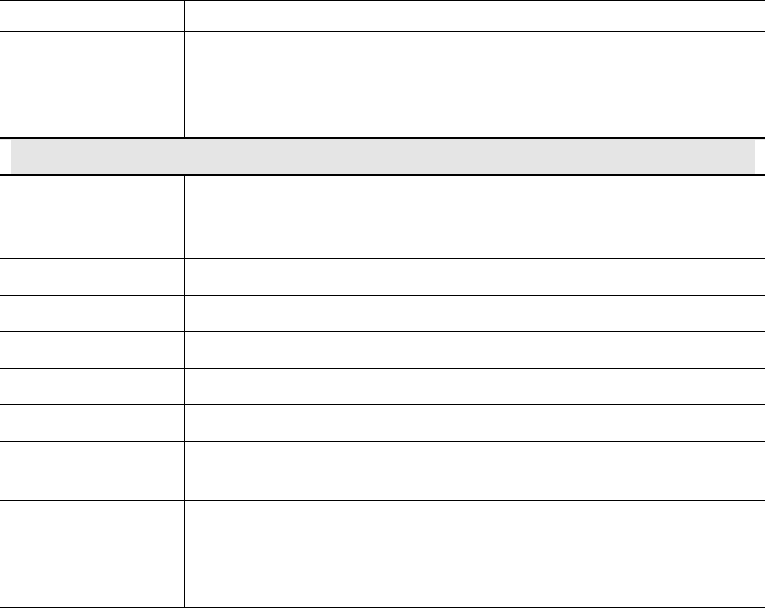
Advanced Features
40
logged.
Buttons Use the "Add" button to create a new rule.
The other buttons - Edit, Move, or Delete - require that a rule be
selected first. Use the radio buttons in the left column to select the
desired rule.
Outgoing Rules
# For the default rule, this will display "Default".
For other rules, this will display a radio button which allows you to
select the rule.
Enable Indicates whether or not the rule is currently enabled.
Service Name The Service covered by this rule.
Action The action performed on connections which are covered by this rule.
LAN Users The LAN PC or PCs covered by this rule.
WAN Servers The WAN IP address or addresses covered by this rule.
Log Indicates whether or not connections covered by this rule should be
logged.
Buttons Use the "Add" button to create a new rule.
The other buttons - Edit, Move, or Delete - require that a rule be
selected first. Use the radio buttons in the left column to select the
desired rule.
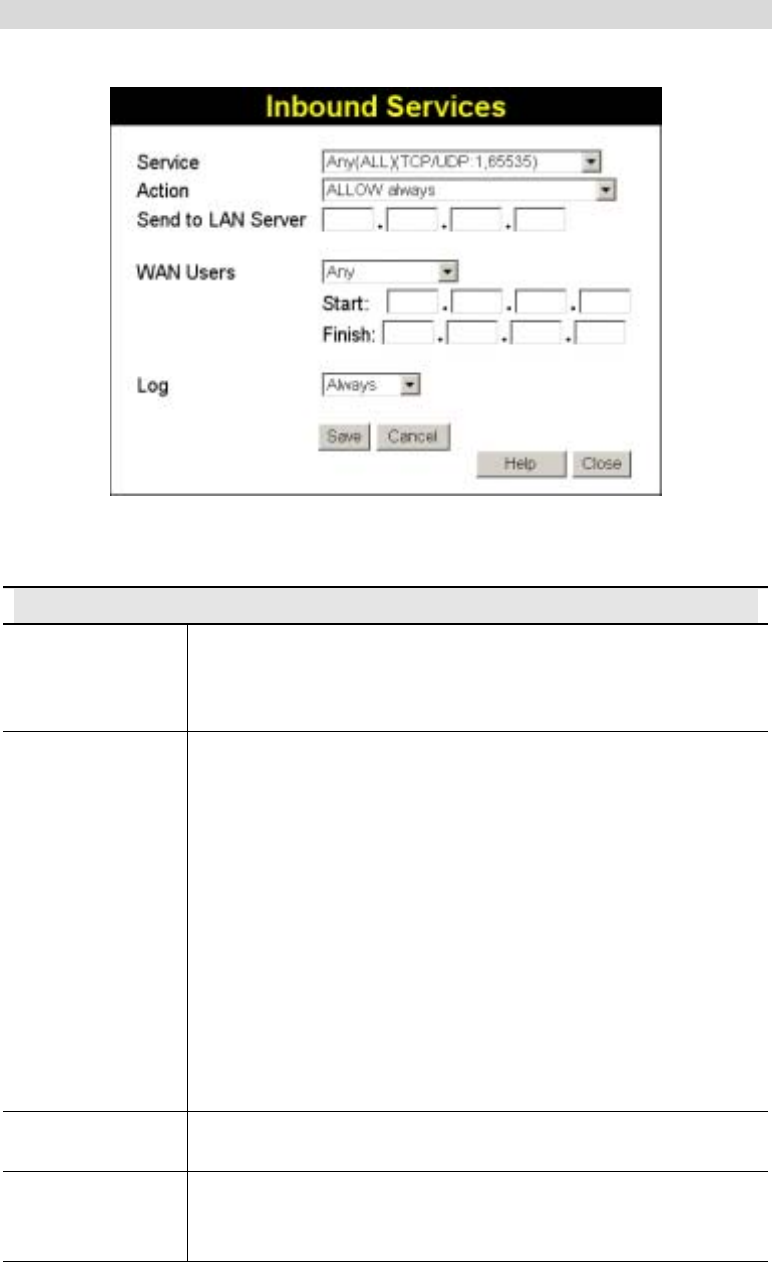
Wireless ADSL Router User Guide
41
Incoming Rules
This screen is displayed when the "Add" on "Edit" button for Incoming Rules is clicked.
Figure 29: Inbound Services Screen
Data – Incoming Rules Screen
Inbound Services
Service Select the desired Service. This determines which packets are
covered by this rule. If necessary, you can define a new Service on
the "Services" screen, by defining the protocols and port numbers
used by the Service.
Action Select the desired action for packets covered by this rule:
• ALLOW always
• ALLOW by schedule, otherwise Block
• BLOCK always
• BLOCK by schedule, otherwise Allow
Note:
• Any inbound traffic which is not allowed by rules you create
will be blocked by the Default rule.
• BLOCK rules are only useful if the traffic is already covered by
an ALLOW rule. (That is, you wish to block a sub-set of traffic
which is currently allowed by another rule.)
• To define the Schedule used in these selections, use the
"Schedule" screen.
LAN Users Enter the IP address of the PC or Server on your LAN which will
receive the inbound traffic covered by this rule.
WAN Users These settings determine which packets are covered by the rule,
based on their source (WAN) IP address. Select the desired option:
• Any - All IP addresses are covered by this rule.
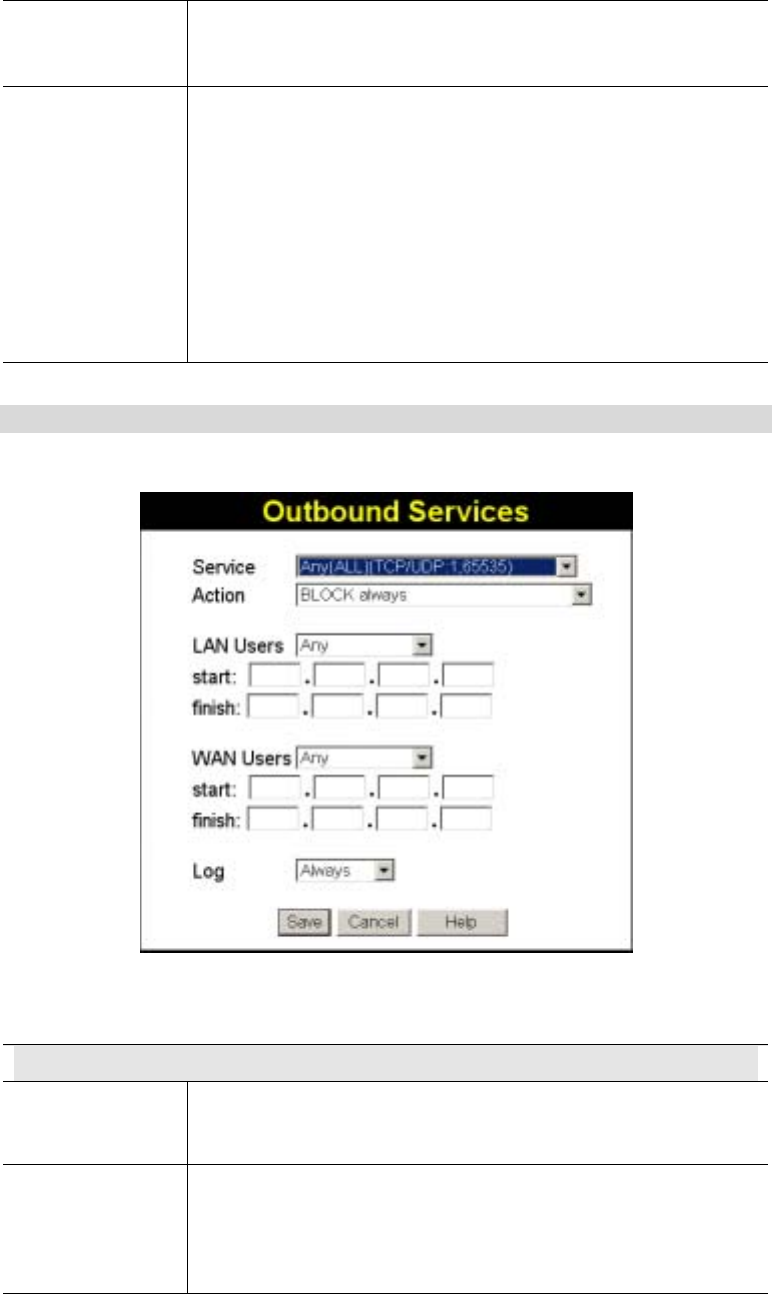
Advanced Features
42
• Address range - If this option is selected, you must enter the
"Start" and "Finish" fields.
• Single address - Enter the required address in the "Start" fields.
Log This determines whether packets covered by this rule are logged.
Select the desired action.
• Always - always log traffic considered by this rule, whether it
matches or not. (This is useful when debugging your rules.)
• Never - never log traffic considered by this rule, whether it
matches or not.
• Match - Log traffic only it matches this rule. (The action is
determined by this rule.)
• Not Match - Log traffic which is considered by this rule, but
does not match (The action is NOT determined by this rule.)
Outgoing Rules
This screen is displayed when the "Add" on "Edit" button for Outgoing Rules is clicked.
Figure 30: Outbound Services Screen
Data - Outbound Rules Screen
Outbound Services
Service Select the desired Service or application to be covered by this rule. If
the desired service or application does not appear in the list, you
must define it using the Services menu.
Action Select the desired action for packets covered by this rule:
• BLOCK always
• BLOCK by schedule, otherwise Allow
• ALLOW always

Wireless ADSL Router User Guide
43
• ALLOW by schedule, otherwise Block
Note:
• Any outbound traffic which is not blocked by rules you create
will be allowed by the Default rule.
• ALLOW rules are only useful if the traffic is already covered by
a BLOCK rule. (That is, you wish to allow a subset of traffic
which is currently blocked by another rule.)
• To define the Schedule used in these selections, use the
"Schedule" screen.
LAN Users Enter the IP address of the PC or Server on your LAN which will
receive the inbound traffic covered by this rule.
WAN Users These settings determine which packets are covered by the rule,
based on their source (WAN) IP address. Select the desired option:
• Any - All IP addresses are covered by this rule.
• Address range - If this option is selected, you must enter the
"Start" and "Finish" fields.
• Single address - Enter the required address in the "Start" fields.
Log This determines whether packets covered by this rule are logged.
Select the desired action.
• Always - always log traffic considered by this rule, whether it
matches or not. (This is useful when debugging your rules.)
• Never - never log traffic considered by this rule, whether it
matches or not.
• Match - Log traffic only it matches this rule. (The action is
determined by this rule.)
• Not Match - Log traffic which is considered by this rule, but
does not match (The action is NOT determined by this rule.)
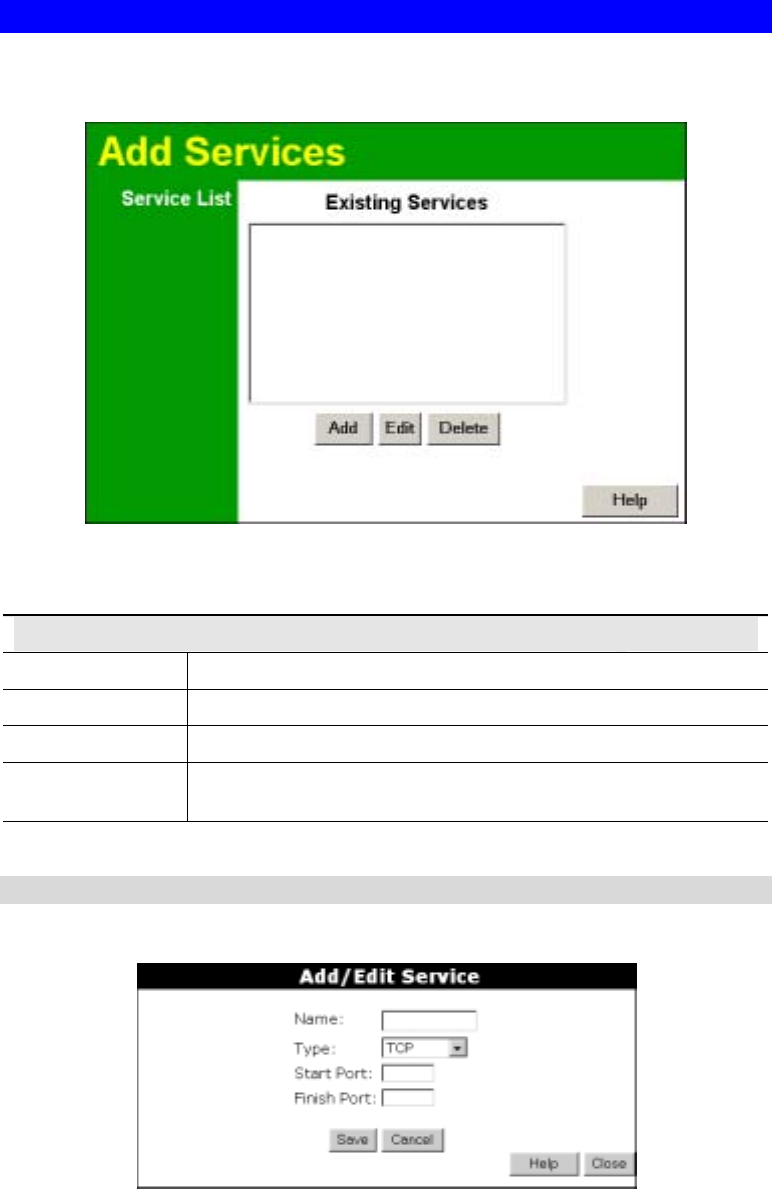
Advanced Features
44
Services
This screen is used to modify the list of Services which are available when creating Firewall
Rules.
Figure 31: Firewall Services
Data – Services
Services
Services List This lists all defined Services.
Add Use this to open a sub-screen where you can add a new service.
Edit To modify a service, select it, and then click this button.
Delete Pre-defined Services can not be deleted, but you can use this button
to delete any services you have defined.
Add/Edit Service
This screen is displayed when the Add or Edit button on the Services screen is clicked.
Figure 32 : Add/Edit Service

Wireless ADSL Router User Guide
45
Data – Add/Edit Service
Services
Name If editing, this shows the current name of the Service.
If adding a new service, this will be blank, and you should enter a
suitable name.
Type Select the protocol used by the Service.
Start Port Enter the beginning of the port range used by the Service.
Finish Port Enter the end of the port range used by the Service.
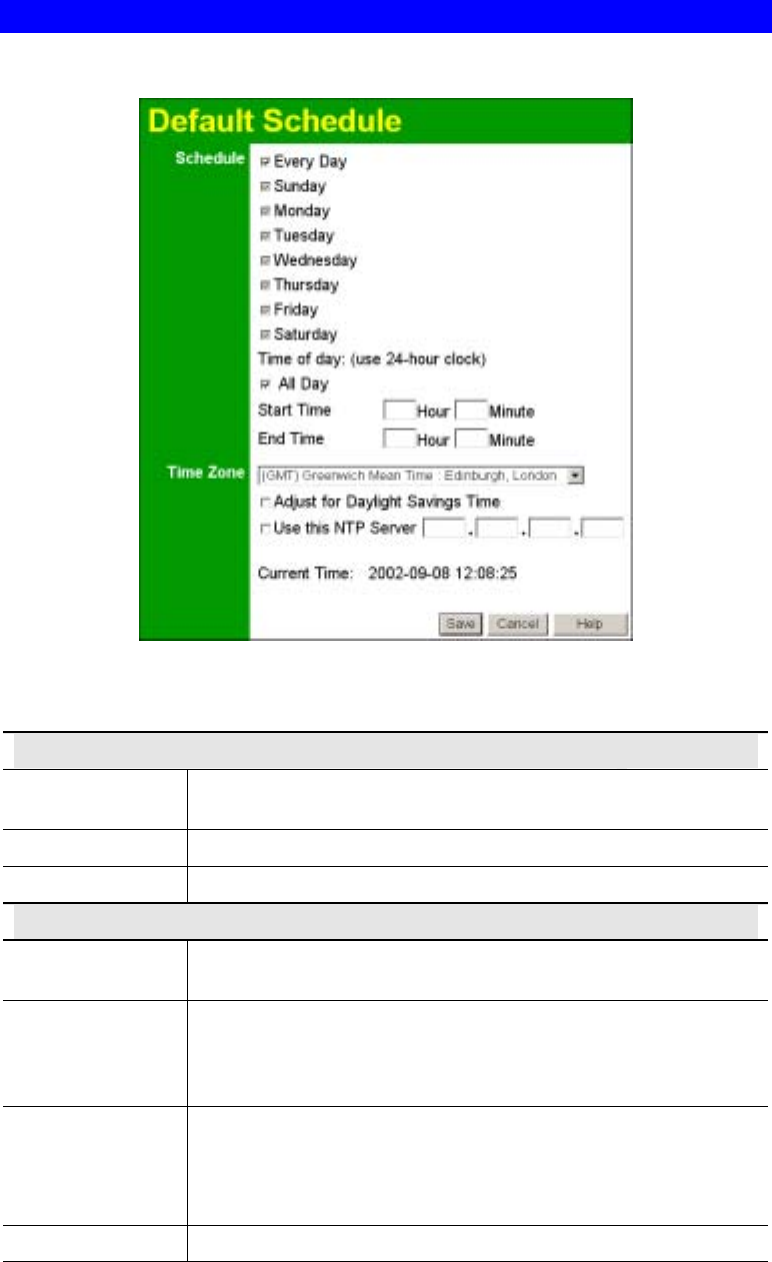
Advanced Features
46
Schedule
This Schedule can be used for the Firewall Rules and the URL filter.
Figure 33: Schedule Screen
Data - Schedule Screen
Schedule
Sunday,
Monday… Use these checkboxes to select the desired days.
Start Time Enter the start using a 24 hr clock.
Finish Time Enter the finish time using a 24 hr clock.
Local Time
Time Zone In order to display your local time correctly, you must select your
"Time Zone" from the list.
Adjust for
Daylight Savings
Time
If your region uses Daylight Savings Time, you must manually check
"Adjust for Daylight Savings Time" at the beginning of the
adjustment period, and uncheck it at the end of the Daylight Savings
period.
Use this NTP
Server If you prefer to use a particular NTP server as the primary server,
check the checkbox "Use this NTP Server" and enter the Server's IP
address in the fields provided..
If this setting is not enabled, the default NTP Servers are used.
Current Time This displays the current time on the Wireless ADSL Router.
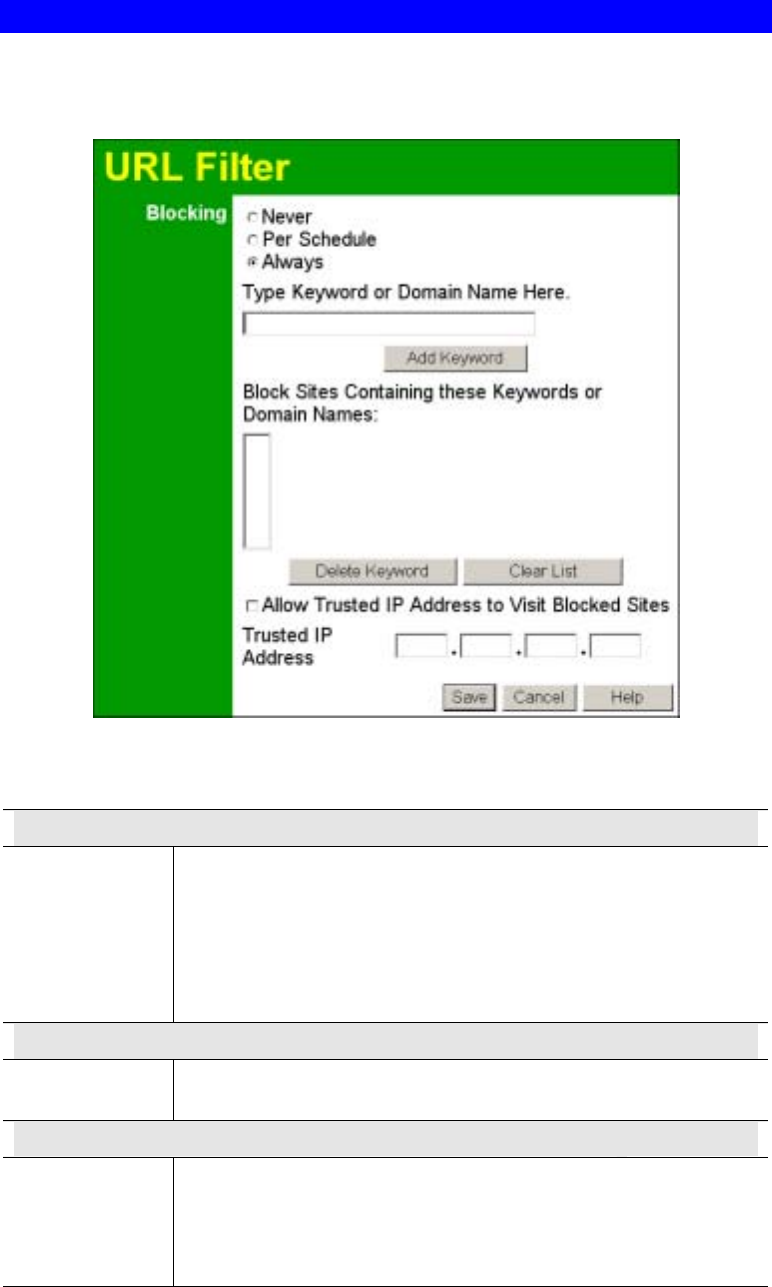
Wireless ADSL Router User Guide
47
URL Filter
If you want to limit access to certain sites on the Internet, you can use this feature. The URL
filter will check each Web site access. If the address, part of the address, is included in the
block site list, access will be denied.
Figure 34: URL Filter Screen
Data - URL Filter Screen
Blocking
Blocking Select the desired option:
• Never - disable this feature.
• By Schedule - block according to the settings on the Schedule
page.
• Always - allow blocking all of the time, independent of the
Schedule page.
Add Site
Keyword or
Domain Name Type the word or domain name you want to block, then click the
"Add" button.
Block List
Block Sites The list contains the current list of items to block.
• To add to the list, use the "Add" option above.
• To delete an entry, select it and click "Delete Keyword" button.
• To delete all entries, click the "Clear List" button.
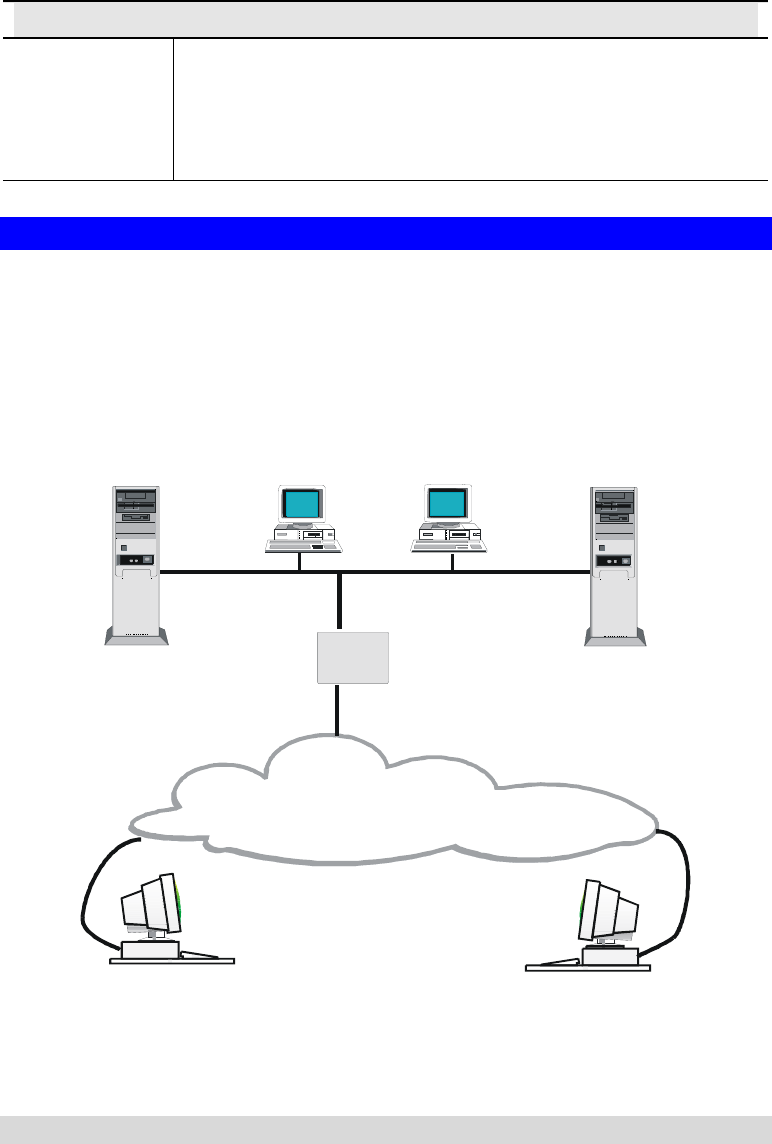
Advanced Features
48
Trusted PC
Allow Trusted
PC Enable this to allow one computer to have Unrestricted Access to the
Internet. For this PC, any restrictions set by the blocking above will be
ignored.
Trusted IP
Address Type the IP address of the computer in the fields provided.
Virtual Servers
This feature, sometimes called Port Forwarding, allows you to make Servers on your LAN
accessible to Internet users. Normally, Internet users would not be able to access a server on
your LAN because:
• Your Server does not have a valid external IP Address.
• Attempts to connect to devices on your LAN are blocked by the firewall in this device.
The "Virtual Server" feature solves these problems and allows Internet users to connect to your
servers, as illustrated below.
Wireless
Router
Web Server FTP Server
Internet
Remote PC Remote PC
Using Web Server Using FTP Server
(http://203.70.212.52) (ftp://203.70.212.52)
203.70.212.52
192.168.0.1
(192.168.0.10) (192.168.0.20)
(LAN IP Address)
(Internet IP Address)
Figure 35: Virtual Servers
IP Address seen by Internet Users
Note that, in this illustration, both Internet users are connecting to the same IP Address, but
using different protocols.
To Internet users, all virtual Servers on your LAN have the same IP Address.
This IP Address is allocated by your ISP.
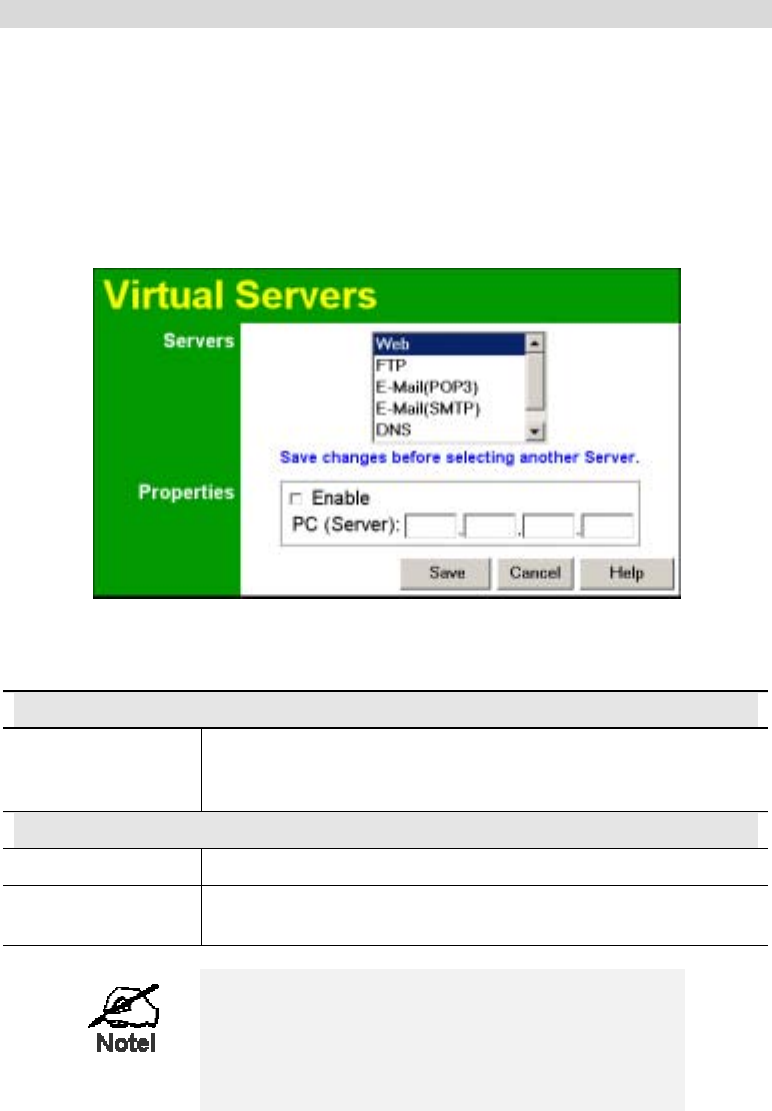
Wireless ADSL Router User Guide
49
This address should be static, rather than dynamic, to make it easier for Internet users to
connect to your Servers.
However, you can use the DDNS (Dynamic DNS) feature to allow users to connect to your
Virtual Servers using a URL, instead of an IP Address.
Virtual Servers Screen
• The "Virtual Servers" feature allows Internet Users to access PCs on your LAN.
• The PCs must be running the appropriate Server Software.
• For Internet Users, ALL of your Servers have the same IP address. This IP address is
allocated by your ISP.
• To make it easier for Internet users to connect to your Servers, you can use the "DDNS"
feature. This allows Internet users to connect to your Servers with a URL, rather than an
IP address. This technology works even if your ISP allocates dynamic IP addresses (IP
address is allocated upon connection, so it may change each time you connect).
Figure 36: Virtual Servers Screen
Data - Virtual Servers Screen
Servers
Servers This lists a number of pre-defined Servers, plus any Servers you
have defined. Details of the selected Server are shown in the
"Properties" area.
Properties
Enable Use this to Enable or Disable support for this Server, as required.
PC (Server) Enter the IP address of the PC for this Server. The PC must be
running the appropriate Server software.
For each entry, the PC must be running the
appropriate Server software.
If the desired Server type is not listed, you can
define your own Servers, using the Firewall Rules.

Advanced Features
50
Connecting to the Virtual Servers
Once configured, anyone on the Internet can connect to your Virtual Servers. They must use
the Internet IP Address (the IP Address allocated to you by your ISP).
e.g. http://203.70.212.52
ftp://203.70.212.52
It is more convenient if you are using a Fixed IP Address from your ISP, rather than Dynamic.
However, you can use the Dynamic DNS feature, described in the following section, to allow
users to connect to your Virtual Servers using a URL, rather than an IP Address.
From the Internet, ALL Virtual Servers have
the IP Address allocated by your ISP

51
Chapter 7
Advanced Administration
This Chapter explains the settings available via the "Administration" section
of the menu.
Overview
Normally, it is not necessary to use these screens, or change any settings. These screens and
settings are provided to deal with non-standard situations, or to provide additional options for
advanced users.
The available settings and features are:
Config File Backup or restore the configuration file for the Wireless ADSL Router.
This file contains all the configuration data.
Logs & Email View or clear all logs, set E-Mailing of log files and alerts.
Network
Diagnostics Ping, DNS Lookup.
PC Database This is the list of PCs shown when you select the "DMZ PC" or a
"Virtual Server". This database is maintained automatically, but you can
add and delete entries for PCs which use a Fixed (Static) IP Address.
Remote
Management Allow settings to be changed from the Internet..
Routing Only required if your LAN has other Routers or Gateways.
Firmware
Upgrade Upgrade the Firmware (software) installed in your Wireless ADSL
Router.
7
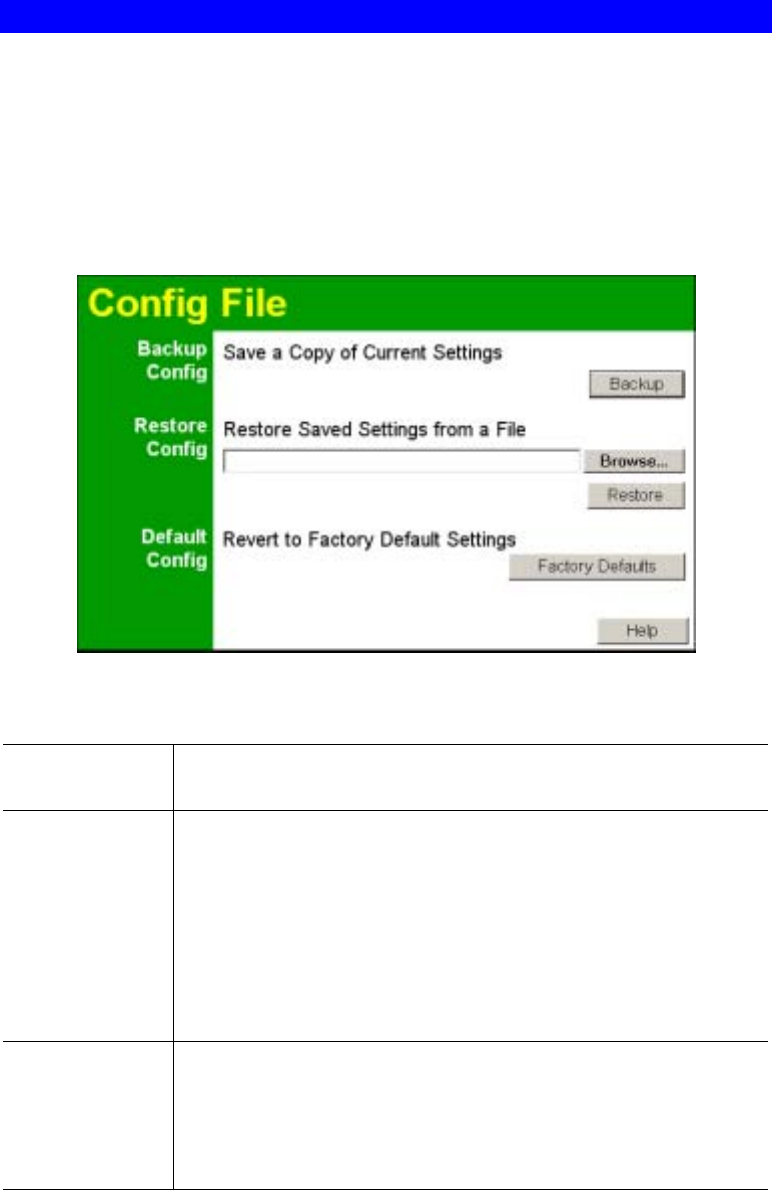
Advanced Administration
52
Config File
This feature allows you to download the current settings from the Wireless ADSL Router, and
save them to a file on your PC.
You can restore a previously-downloaded configuration file to the Wireless ADSL Router, by
uploading it to the Wireless ADSL Router.
This screen also allows you to set the Wireless ADSL Router back to its factory default
configuration. Any existing settings will be deleted.
An example Config File screen is shown below.
Figure 37: Config File Screen
Data - Config File Screen
Backup Config Use this to download a copy of the current configuration, and store the
file on your PC. Click Download to start the download.
Restore Config This allows you to restore a previously-saved configuration file back to
the Wireless ADSL Router.
Click Browse to select the configuration file, then click Restore to
upload the configuration file.
WARNING !
Uploading a configuration file will destroy (overwrite) ALL of the
existing settings.
Default Config Clicking the Factorye Defaults button will reset the Wireless ADSL
Router to its factory default settings.
WARNING !
This will delete ALL of the existing settings.
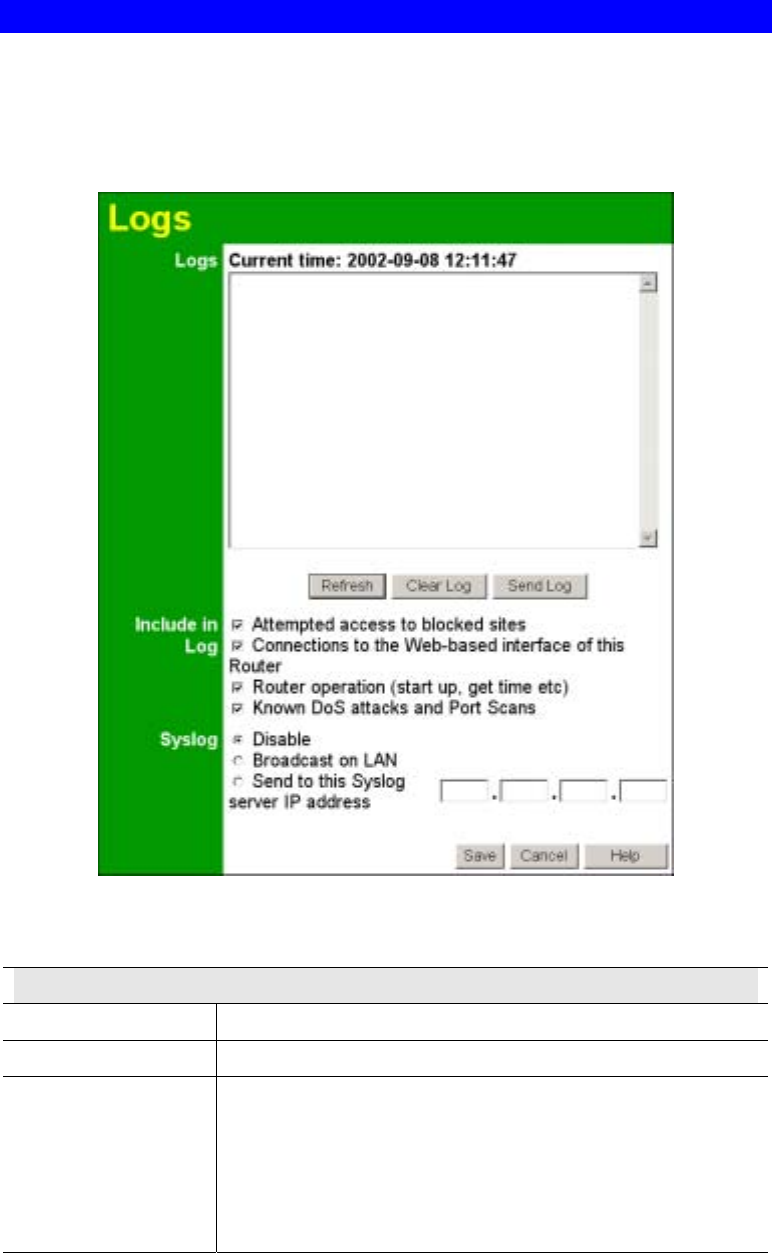
Wireless ADSL Router User Guide
53
Logs
The Logs record various types of activity on the Wireless ADSL Router. This data is useful for
troubleshooting, but enabling all logs will generate a large amount of data and adversely affect
performance.
Since only a limited amount of log data can be stored in the Wireless ADSL Router, log data
can also be E-mailed to your PC. Use the E-mail screen to configure this feature.
Figure 38: Logs Screen
Data - Logs Screen
Logs
Current Time The current time on the Wireless ADSL Router is displayed.
Log Data Current log data is displayed in this panel.
Buttons There are three (3) buttons
• Refresh - Update the log data.
• Clear Log - Clear the log, and restart it. This makes new
messages easier to read.
• Send Log - E-mail the log immediately. This is only
functional if the E-mail screen has been configured.

Advanced Administration
54
Logs
Include (Checkboxes) Use these checkboxes to determine which events are included in
the log. Checking all options will increase the size of the log, so it
is good practice to disable any events which are not really
required.
• Attempted access to blocked sites - If checked, attempted
Internet accesses which were blocked are logged.
• Connections to the Web-based interface of this Router - If
checked, this will log connections TO this Router, rather than
through this Router to the Internet.
• Router operation - If checked, other Router operations (not
covered by the selections above) will be logged.
• Known DoS attacks and Port Scans - If checked, Denial of
Service attacks, as well as port scans, will be logged.
Syslog
Disable Data is not sent to a Syslog Server.
Broadcast on LAN The Syslog data is broadcast, rather than sent to a specific Syslog
server. Use this if your Syslog Server does not have a fixed IP
address.
Syslog If your Syslog server has a fixed IP address, select this option,
and enter the IP address of your Syslog server.
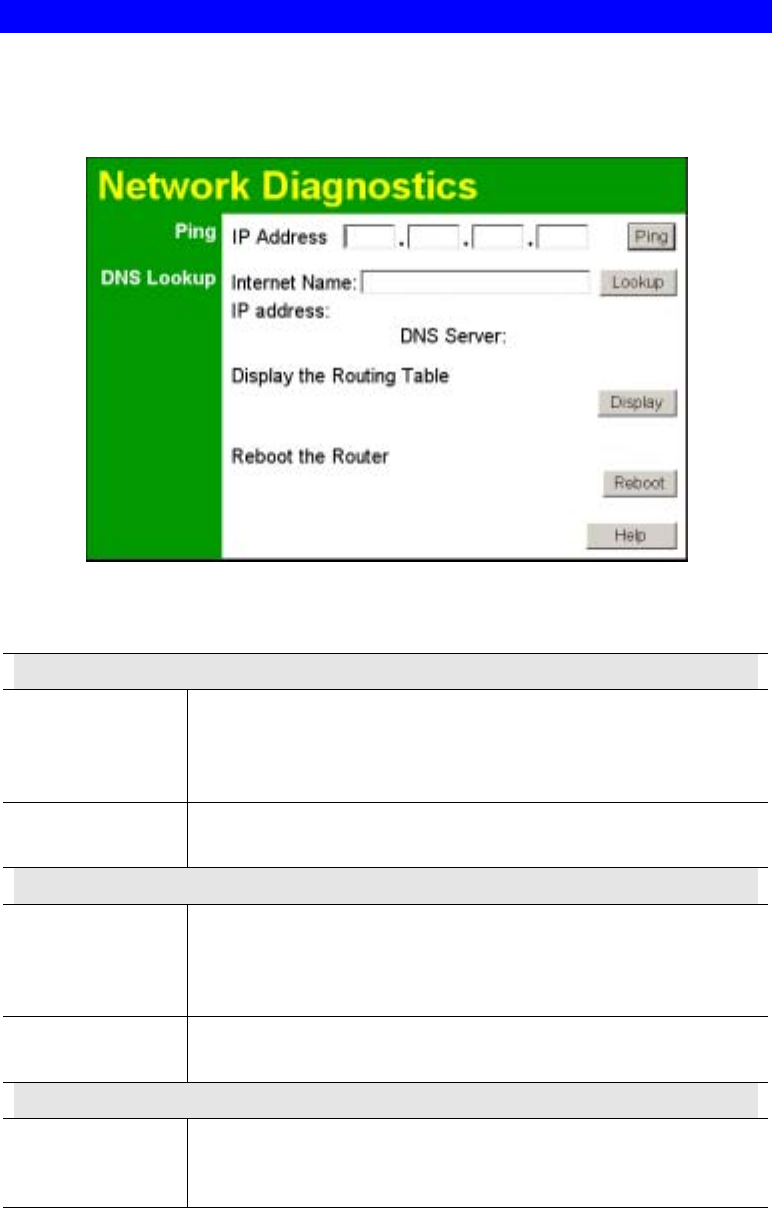
Wireless ADSL Router User Guide
55
Network Diagnostics
This screen allows you to perform a "Ping" or a "DNS lookup". These activities can be useful
in solving network problems.
An example Network Diagnostics screen is shown below.
Figure 39: Network Diagnostics Screen
Data - Network Diagnostics Screen
Ping
Ping this
IP Address Enter the IP address you wish to ping. The IP address can be on your
LAN, or on the Internet. Note that if the address is on the Internet,
and no connection currently exists, you could get a "Timeout" error.
In that case, wait a few seconds and try again.
Ping Button After entering the IP address, click this button to start the "Ping"
procedure. The results will be displayed in the Ping Results pane.
DNS Lookup
Internet name Enter the Domain name or URL for which you want a DNS (Domain
Name Server) lookup. Note that if the address in on the Internet, and
no connection currently exists, you could get a "Timeout" error. In
that case, wait a few seconds and try again.
Lookup Button After entering the Domain name/URL, click this button to start the
"DNS Lookup" procedure.
Routing
Display Click this button to display the internal routing table. This
information can be used by Technical Support and other staff who
understand Routing Tables.
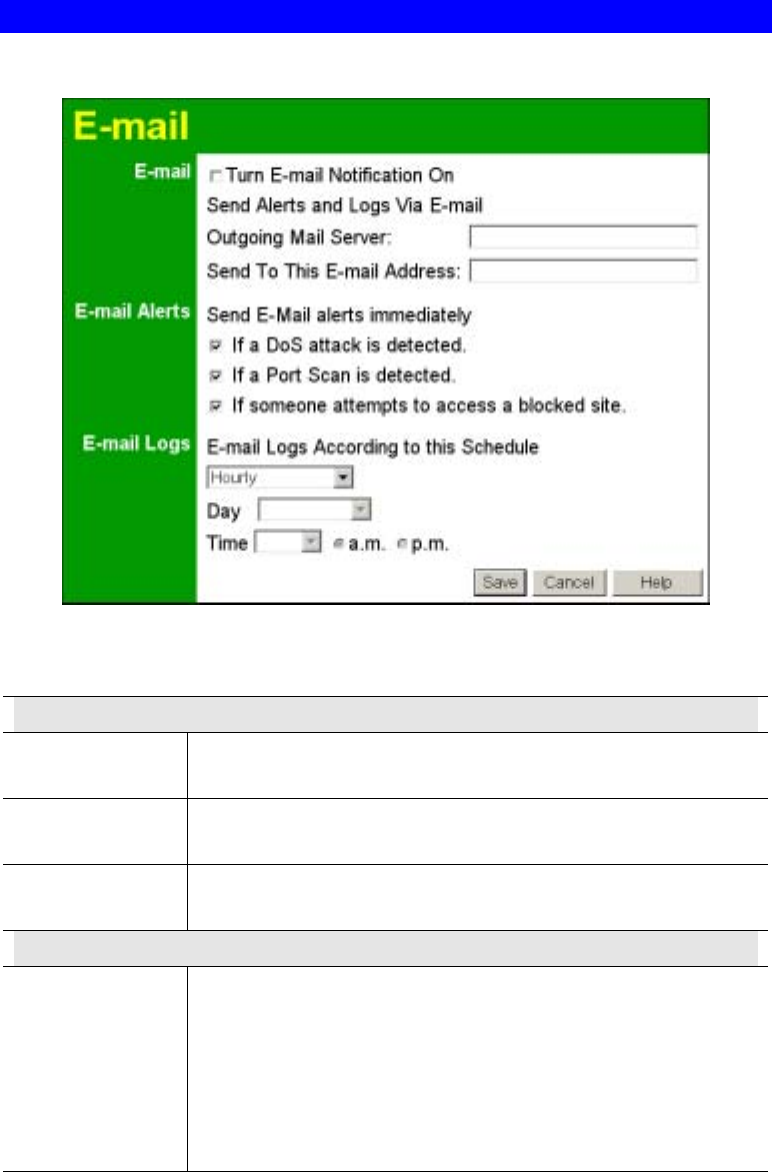
Advanced Administration
56
E-mail
This screen allows you to E-mail Logs and Alerts. A sample screen is shown below.
Figure 40: E-mail Screen
Data – E-mail Screen
E-Mail Notification
Send Logs &
Alerts via E-mail Check this box to enable this feature. If enabled, the E-mail address
information (below) must be provided.
Send to this E-
mail address Enter the E-mail address the Log is to be sent to. The E-mail will also
show this address as the Sender's address.
Outgoing Mail
Server Enter the address or IP address of the SMTP (Simple Mail Transport
Protocol) Server you use for outgoing E-mail.
E-mail Alerts
Send E-mail alerts You can choose to have alerts E-mailed to you, by checking the
desired checkboxes. The Wireless ADSL Router can send an
immediate alert when it detects a significant security incident such as
• A known hacker attack is directed at your IP address
• A computer on the Internet scans your IP address for open ports
• Someone on your LAN (Local Area Network) tries to visit a
blocked site.

Wireless ADSL Router User Guide
57
E-mail Logs
Send Logs Select the desired option for sending the log by E-mail.
• Never (default) - This feature is disabled; Logs are not sent.
• When log is full - The time is not fixed. The log will be sent
when the log is full, which will depend on the volume of traffic.
• Hourly, Daily, Weekly... - The log is sent on the interval
specified.
• If "Daily" is selected, the log is sent at the time specified.
• If the day is specified, the log is sent once per week, on the
specified day.
• Select the time of day you wish the E-mail to be sent.
• If the log is full before the time specified to send it, it will be
sent regardless.
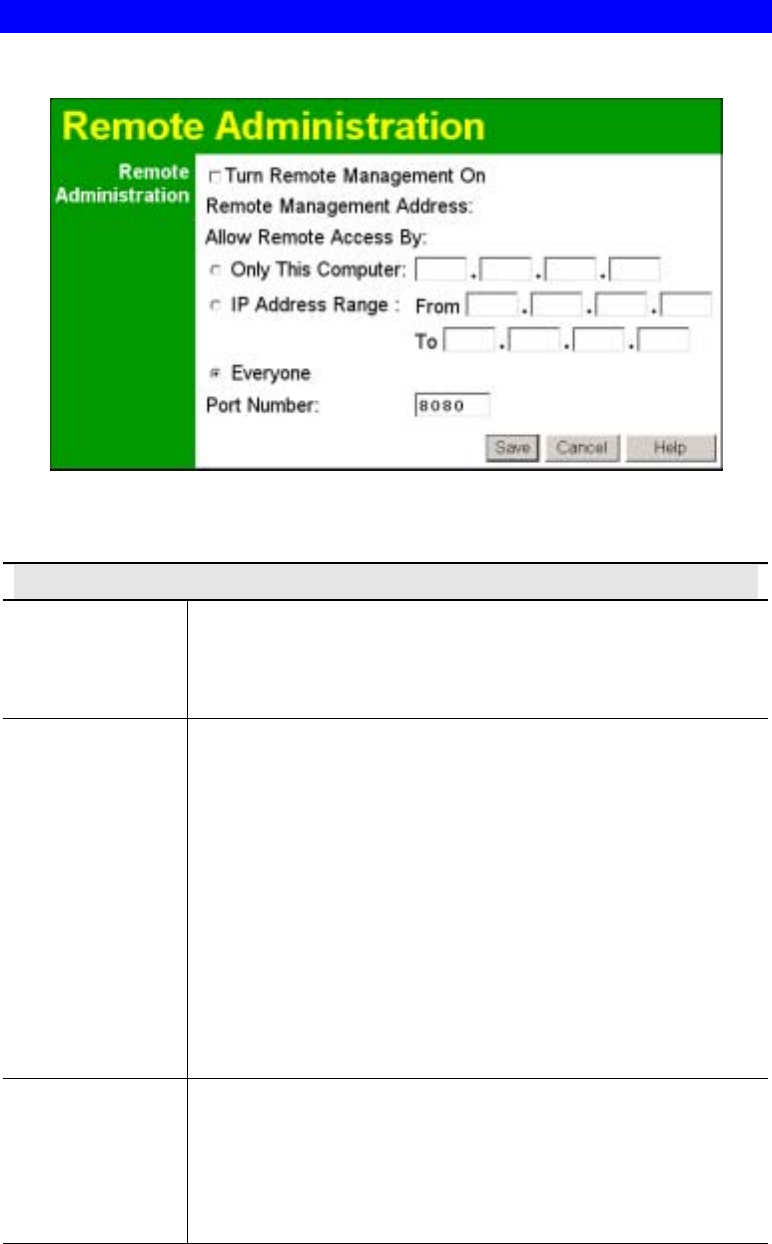
Advanced Administration
58
Remote Admin
If enabled, this feature allows you to manage the Wireless ADSL Router via the Internet.
Figure 41: Remote Administration Screen
Data - Remote Administration Screen
Remote Administration
Enable Remote
Management Check to allow adminstration/management via the Internet. (To
connect, see below).
If Disabled, this device will ignore Administration connection
attempts from the Internet.
Remote
Management
Address
This is the current address you will use When accessing your Router
from the Internet. To access the Router:
1. From a remote location, start your Browser.
2. In the "Address" or "Location" field, enter the Internet IP
address of this device (NOT the LAN IP address), followed by
the port number, as follows:
http://ip_address:port_number
Where:
ip_address is the Internet IP address of this device.
port_number is the port number assigned on this screen.
3. You should then be prompted for the password for this device.
(You must assign a password!)
Port Number Enter a port number between 1024 and 65535. The default for HTTP
(Web) connections is port 80, but using port 80 will prevent the use
of a Web "Virtual Server" on your LAN. So using a different port
number is recommended. The default value is 8080.
The port number must be specified in your Browser when you
connect, as detailed above.

Wireless ADSL Router User Guide
59
Access Permission
Allow Remote
Access Select the desired option.
• Everyone - allow access by everyone on the Internet.
• Only This Computer - allow access by only one IP address.
Enter the desired IP address.
• IP Address Range - allow access from a range of IP addresses
on the Internet. Enter a beginning and ending IP address to
define the allowed range.
For security, you should restrict access to as few external IP
addresses as practical.
To connect from a remote PC via the Internet
1. Ensure your Internet connection is established, and start your Web Browser.
2. In the "Address" bar, enter "HTTP://" followed by the Internet IP Address of the Wireless
ADSL Router. If the port number is not 80, the port number is also required. (After the IP
Address, enter ":" followed by the port number.)
e.g.
HTTP://123.123.123.123:8080
This example assumes the WAN IP Address is 123.123.123.123, and the port number is 8080.

Advanced Administration
60
Routing
Overview
• If you don't have other Routers or Gateways on your LAN, you can ignore the "Routing"
page completely.
• If the Wireless ADSL Router is only acting as a Gateway for the local LAN segment,
ignore the "Routing" page even if your LAN has other Routers.
• If your LAN has a standard Router (e.g. Cisco) on your LAN, and the Wireless ADSL
Router is to act as a Gateway for all LAN segments, enable RIP (Routing Information
Protocol) and ignore the Static Routing table.
• If your LAN has other Gateways and Routers, and you wish to control which LAN
segments use each Gateway, do NOT enable RIP (Routing Information Protocol).
Configure the Static Routing table instead. (You also need to configure the other Routers.)
• If using Windows 2000 Data center Server as a software Router, enable RIP on the
Wireless ADSL Router, and ensure the following Windows 2000 settings are correct:
• Open Routing and Remote Access
• In the console tree, select Routing and Remote Access , [server name], IP Routing,
RIP
• In the "Details" pane, right-click the interface you want to configure for RIP version 2,
and then click "Properties".
• On the "General" tab, set Outgoing packet protocol to "RIP version 2 broadcast", and
Incoming packet protocol to "RIP version 1 and 2".
Routing Screen
The routing table is accessed by the Routing link on the Administration menu.
Using this Screen
Generally, you will use either RIP (Routing Information Protocol) OR the Static Routing Table,
as explained above, although is it possible to use both methods simultaneously.
Static Routing Table
• If RIP is not used, an entry in the routing table is required for each LAN segment on your
Network, other than the segment to which this device is attached.
• The other Routers must also be configured. See Configuring Other Routers on your LAN
later in this chapter for further details and an example.
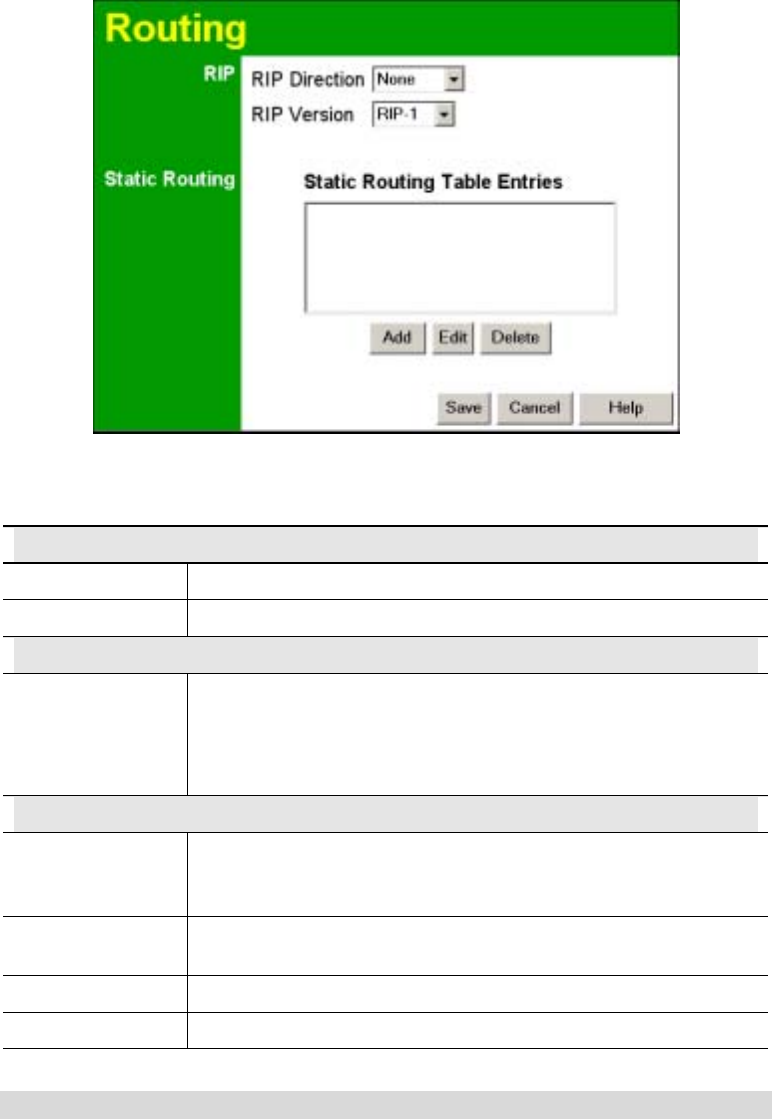
Wireless ADSL Router User Guide
61
Figure 42: Routing Screen
Data - Routing Screen
RIP
RIP Direction Select the desired RIP Direction.
RIP Version Choose the RIP Version for the Server.
Static Routing
Static Routing
Table Entries This list shows all entries in the Routing Table.
• This area shows details of the selected item in the list.
• Change any the properties as required, then click the "Edit"
button to save the changes to the selected entry.
Buttons
Add Add a new entry to the Static Routing table, using the data shown in
the "Properties" area on screen. The entry selected in the list is
ignored, and has no effect.
Edit Update the current Static Routing Table entry, using the data shown
in the table area on screen.
Delete Delete the current Static Routing Table entry.
Save Save the RIP setting. This has no effect on the Static Routing Table.
Configuring Other Routers on your LAN
It is essential that all IP packets for devices not on the local LAN be passed to the Wireless
ADSL Router, so that they can be forwarded to the external LAN, WAN, or Internet. To
achieve this, the local LAN must be configured to use the Wireless ADSL Router as the
Default Route or Default Gateway.
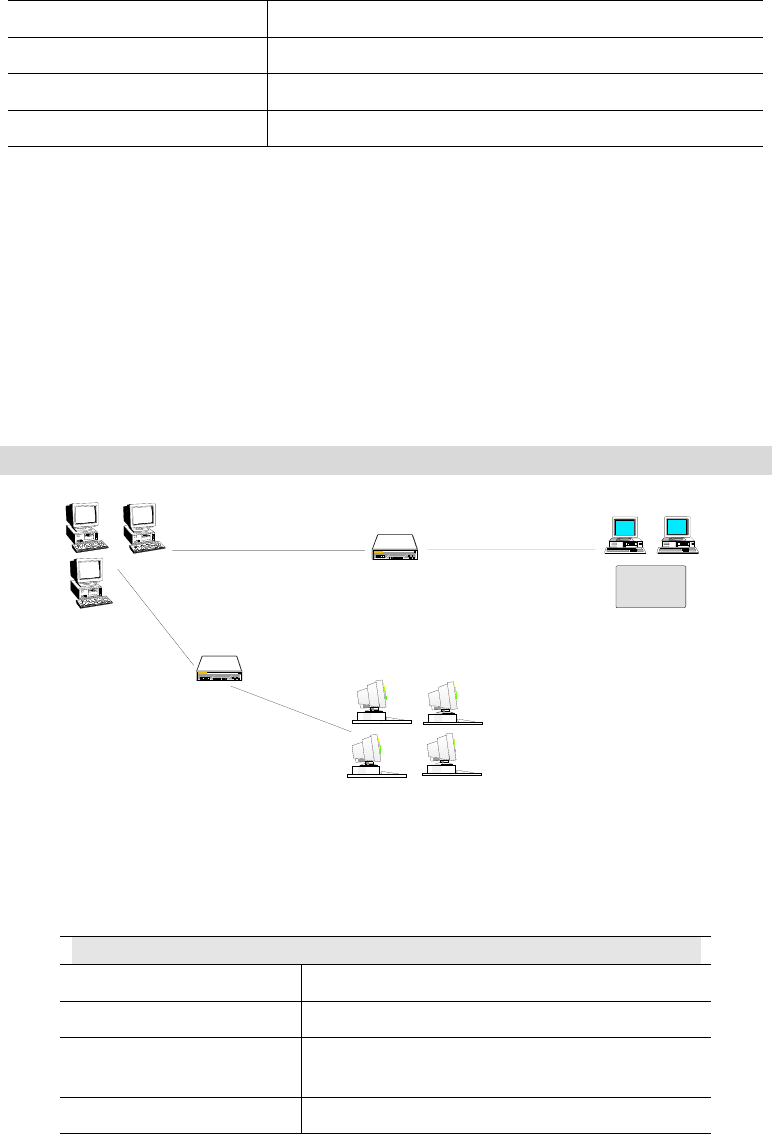
Advanced Administration
62
Local Router
The local router is the Router installed on the same LAN segment as the Wireless ADSL
Router. This router requires that the Default Route is the Wireless ADSL Router itself.
Typically, routers have a special entry for the Default Route. It should be configured as follows.
Destination IP Address Normally 0.0.0.0, but check your router documentation.
Network Mask Normally 0.0.0.0, but check your router documentation.
Gateway IP Address The IP Address of the Wireless ADSL Router.
Metric 1
Other Routers on the Local LAN
Other routers on the local LAN must use the Wireless ADSL Router's Local Router as the
Default Route. The entries will be the same as the Wireless ADSL Router's local router, with
the exception of the Gateway IP Address.
• For a router with a direct connection to the Wireless ADSL Router's local Router, the
Gateway IP Address is the address of the Wireless ADSL Router's local router.
• For routers which must forward packets to another router before reaching the Wireless
ADSL Router's local router, the Gateway IP Address is the address of the intermediate
router.
Static Routing - Example
Router B
(192.168.1.90) (192.168.2.70)
Router A
Segment 0
Segment 2
Segment 1
Wireless
(192.168.0.xx)
(192.168.1.xx)
(192.168.0.100)
(192.168.0.1)
(192.168.2.xx)
(192.168.1.80)
Router
Figure 43: Routing Example
For the Wireless ADSL Router's Routing Table
For the LAN shown above, with 2 routers and 3 LAN segments, the Wireless ADSL Router
requires 2 entries as follows.
Entry 1 (Segment 1)
Destination IP Address 192.168.1.0
Network Mask 255.255.255.0 (Standard Class C)
Gateway IP Address 192.168.0.100 (Wireless ADSL Router's local
Router)
Metric 2

Wireless ADSL Router User Guide
63
Entry 2 (Segment 2)
Destination IP Address 192.168.2.0
Network Mask 255.255.255.0 (Standard Class C)
Gateway IP Address 192.168.0.100
Metric 3
For Router A's Default Route
Destination IP Address 0.0.0.0
Network Mask 0.0.0.0
Gateway IP Address 192.168.0.1 (Wireless ADSL Router's IP
Address)
For Router B's Default Route
Destination IP Address 0.0.0.0
Network Mask 0.0.0.0
Gateway IP Address 192.168.1.80 (Wireless ADSL Router's local
router)
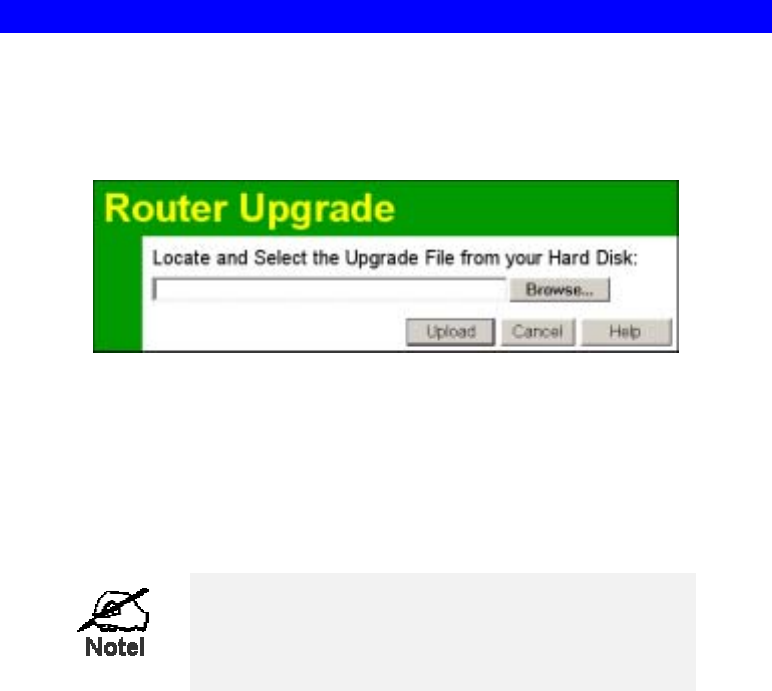
Advanced Administration
64
Router Upgrade
The firmware (software) in the Wireless ADSL Router can be upgraded using your Web
Browser.
You must first download the upgrade file, then select Upgrade on the Administration menu.
You will see a screen like the following.
Figure 44: Router Upgrade Screen
To perform the Firmware Upgrade:
1. Click the "Browse" button and navigate to the location of the upgrade file.
2. Select the upgrade file. Its name will appear in the Upgrade File field.
3. Click the "Start Upgrade" button to commence the firmware upgrade.
The Wireless ADSL Router is unavailable during the
upgrade process, and must restart when the
upgrade is completed. Any connections to or
through the Wireless ADSL Router will be lost.

65
Appendix A
Troubleshooting
This Appendix covers the most likely problems and their solutions.
Overview
This chapter covers some common problems that may be encountered while using the Wireless
ADSL Router and some possible solutions to them. If you follow the suggested steps and the
Wireless ADSL Router still does not function properly, contact your dealer for further advice.
General Problems
Problem 1: Can't connect to the Wireless ADSL Router to configure it.
Solution 1: Check the following:
• The Wireless ADSL Router is properly installed, LAN connections are
OK, and it is powered ON.
• Ensure that your PC and the Wireless ADSL Router are on the same
network segment. (If you don't have a router, this must be the case.)
• If your PC is set to "Obtain an IP Address automatically" (DHCP
client), restart it.
• If your PC uses a Fixed (Static) IP address, ensure that it is using an IP
Address within the range 192.168.0.2 to 192.168.0.254 and thus
compatible with the Wireless ADSL Router's default IP Address of
192.168.0.1.
Also, the Network Mask should be set to 255.255.255.0 to match the
Wireless ADSL Router.
In Windows, you can check these settings by using Control Panel-
Network to check the Properties for the TCP/IP protocol.
Internet Access
Problem 1: When I enter a URL or IP address I get a time out error.
Solution 1: A number of things could be causing this. Try the following troubleshooting
steps.
• Check if other PCs work. If they do, ensure that your PCs IP settings
are correct. If using a Fixed (Static) IP Address, check the Network
Mask, Default gateway and DNS as well as the IP Address.
• If the PCs are configured correctly, but still not working, check the
Wireless ADSL Router. Ensure that it is connected and ON. Connect to
it and check its settings. (If you can't connect to it, check the LAN and
power connections.)
• Check the Wireless ADSL Router's status screen to see if it is working
correctly.
A

Appendix A - Troubleshooting
66
Problem 2: Some applications do not run properly when using the Wireless ADSL
Router.
Solution 2: The Wireless ADSL Router processes the data passing through it, so it is not
transparent.
For incoming connections, you must use the Virtual Server or Firewall
Rules to specify the PC which will receive the incoming traffic.
You can also use the DMZ function. This should work with almost every
application, but:
• It is a security risk, since the firewall is disabled.
• Only one (1) PC can use this feature.
Wireless Access
Problem 1: My PC can't locate the Wireless Access Point.
Solution 1: Check the following.
• Your PC is set to Infrastructure Mode. (Access Points are always in
Infrastructure Mode)
• The SSID on your PC and the Wireless Access Point are the same.
Remember that the SSID is case-sensitive. So, for example
"Workgroup" does NOT match "workgroup".
• Both your PC and the Wireless ADSL Router must have the same
setting for WEP. The default setting for the Wireless ADSL Router is
disabled, so your wireless station should also have WEP disabled.
• If WEP is enabled on the Wireless ADSL Router, your PC must have
WEP enabled, and the key must match.
• If the Wireless ADSL Router's Wireless screen is set to Allow Trusted
PCs only, then each of your Wireless stations must have been
designated as "Trusted", or the Wireless station will be blocked.
• To see if radio interference is causing a problem, see if connection is
possible when close to the Wireless ADSL Router.
Remember that the connection range can be as little as 100 feet in poor
environments.
Problem 2: Wireless connection speed is very slow.
Solution 2: The wireless system will connect at the highest possible speed, depending
on the distance and the environment. To obtain the highest possible
connection speed, you can experiment with the following:
• Wireless ADSL Router location.
Try adjusting the location and orientation of the Wireless ADSL
Router.
• Wireless Channel
If interference is the problem, changing to another channel may show a
marked improvement.
• Radio Interference
Other devices may be causing interference. You can experiment by
switching other devices Off, and see if this helps. Any "noisy" devices
should be shielded or relocated.
• RF Shielding
Wireless ADSL Router User Guide
67
Your environment may tend to block transmission between the wireless
stations. This will mean high access speed is only possible when close
to the Wireless ADSL Router.
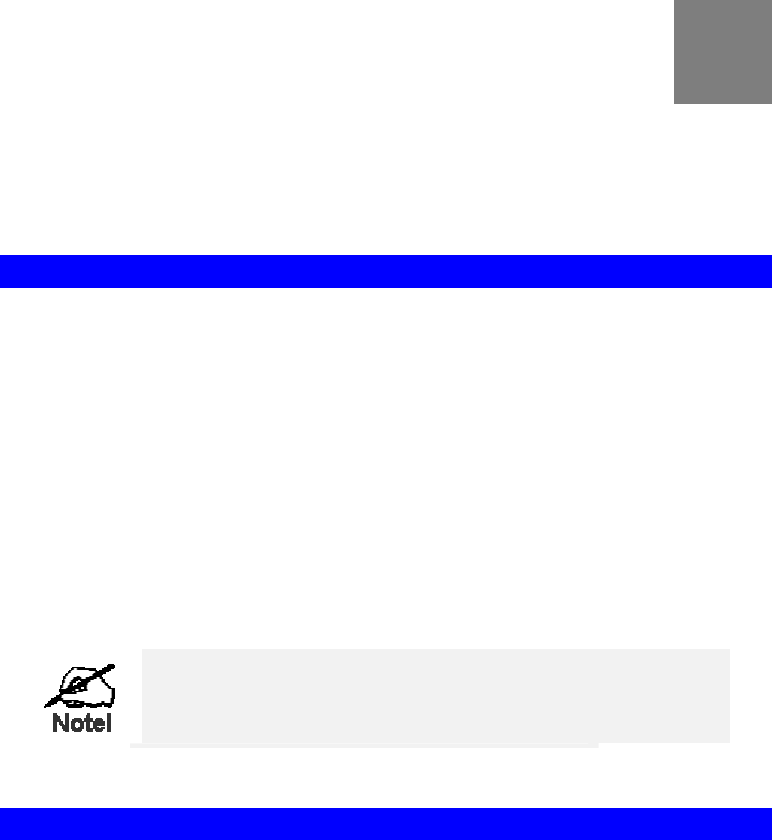
68
Appendix B
About Wireless LANs
This Appendix provides some background information about using Wireless
LANs (WLANs).
Modes
Wireless LANs can work in either of two (2) modes:
• Ad-hoc
• Infrastructure
Ad-hoc Mode
Ad-hoc mode does not require an Access Point or a wired (Ethernet) LAN. Wireless
Stations (e.g. notebook PCs with wireless cards) communicate directly with each other.
Infrastructure Mode
In Infrastructure Mode, one or more Access Points are used to connect Wireless Stations
(e.g. Notebook PCs with wireless cards) to a wired (Ethernet) LAN. The Wireless Stations
can then access all LAN resources.
Access Points can only function in "Infrastructure" mode,
and can communicate only with Wireless Stations which are
set to "Infrastructure" mode.
BSS/ESS
BSS
A group of Wireless Stations and a single Access Point, all using the same ID (SSID), form a
Basic Service Set (BSS).
Using the same SSID is essential. Devices with different SSIDs are unable to communicate
with each other.
ESS
A group of Wireless Stations, and multiple Access Points, all using the same ID (ESSID), form
an Extended Service Set (ESS).
Different Access Points within an ESS can use different Channels. In fact, to reduce
interference, it is recommended that adjacent Access Points SHOULD use different channels.
As Wireless Stations are physically moved through the area covered by an ESS, they will
automatically change to the Access Point which has the least interference or best performance.
This capability is called Roaming. (Access Points do not have or require Roaming capabilities.)
B

Wireless ADSL Router User Guide
69
Channels
The Wireless Channel sets the radio frequency used for communication.
• Access Points use a fixed Channel. You can select the Channel used. This allows you to
choose a Channel which provides the least interference and best performance. In the USA
and Canada, 11 channel are available. If using multiple Access Points, it is better if
adjacent Access Points use different Channels to reduce interference.
• In "Infrastructure" mode, Wireless Stations normally scan all Channels, looking for an
Access Point. If more than one Access Point can be used, the one with the strongest signal
is used. (This can only happen within an ESS.)
• If using "Ad-hoc" mode (no Access Point), all Wireless stations should be set to use the
same Channel. However, most Wireless stations will still scan all Channels to see if there
is an existing "Ad-hoc" group they can join.
WEP
WEP (Wired Equivalent Privacy) is a standard for encrypting data before it is transmitted.
This is desirable because it is impossible to prevent snoopers from receiving any data which is
transmitted by your Wireless Stations. But if the data is encrypted, then it is meaningless
unless the receiver can decrypt it.
If WEP is used, the Wireless Stations and the Access Point must have the same settings
for each of the following:
WEP Off, 64 Bit, 128 Bit
Key For 64 Bit encryption, the Key value must match.
For 128 Bit encryption, the Key value must match
WEP Authentication Open System or Shared Key.
Wireless LAN Configuration
To allow Wireless Stations to use the Access Point, the Wireless Stations and the Access Point
must use the same settings, as follows:
Mode On client Wireless Stations, the mode must be set to "Infrastructure".
(The Access Point is always in "Infrastructure" mode.)
SSID (ESSID) Wireless Stations should use the same SSID (ESSID) as the Access
Point they wish to connect to. Alternatively, the SSID can be set to "any"
or null (blank) to allow connection to any Access Point.
WEP The Wireless Stations and the Access Point must use the same settings
for WEP (Off, 64 Bit, 128 Bit).
WEP Key: If WEP is enabled, the Key must be the same on the
Wireless Stations and the Access Point.
WEP Authentication: If WEP is enabled, all Wireless Stations must
use the same setting as the Access Point (either "Open System" or
"Shared Key").

70
Appendix C
Specifications
Multi-Function Wireless ADSL Router
Model Wireless ADSL Router
Dimensions 189mm(W) * 122mm(D) * 27mm(H)
Operating Temperature 0° C to 40° C
Storage Temperature -10° C to 70° C
Network Protocol: TCP/IP
Network Interface: 4 * 10/100BaseT (RJ45) LAN connection
1 * RJ11 for ADSL
LEDs 12
Power Adapter 15 V External
Wireless Interface
Standards IEEE802.11g WLAN,
Frequency 2.4 to 2.4835GHz (Industrial Scientific Medical Band )
Channels Maximum 14 Channels, depending on regulatory authorities
Modulation DSSS BPSK/QPSK/CCK, OFDM/CCK
Data Rate Up to 54 Mbps
Coverage Area Indoors : 15m @54Mbps, 120m @6Mbps or lower
Outdoors : 40m @54Mbps, 300m @6Mbps or lower
WEP 64Bit, 128Bit
Output Power 13dBm (typical)
Receiver Sensitivity -80dBm Min.
C

Wireless ADSL Router User Guide
71
Regulatory Approvals
FCC Statement
This equipment has been tested and found to comply with the limits for a Class B digital
device, pursuant to Part 15 of the FCC Rules. These limits are designed to provide reasonable
protection against harmful interference in a residential installation.
This equipment generates, uses and can radiate radio frequency energy and, if not installed and
used in accordance with the instructions, may cause harmful interference to radio
communications. However, there is no guarantee that interference will not occur in a particular
installation. If this equipment does cause harmful interference to radio or television reception,
which can be determined by turning the equipment off and on, the user is encouraged to try to
correct the interference by one of the following measures:
• Reorient or relocate the receiving antenna.
• Increase the separation between the equipment and receiver.
• Connect the equipment into an outlet on a circuit different from that to which the receiver
is connected.
• Consult the dealer or an experienced radio/TV technician for help.
To assure continued compliance, any changes or modifications not expressly approved by the
party responsible for compliance could void the user's authority to operate this equipment.
(Example - use only shielded interface cables when connecting to computer or peripheral
devices).
FCC Radiation Exposure Statement
This equipment complies with FCC RF radiation exposure limits set forth for an uncontrolled
environment. This equipment should be installed and operated with a minimum distance of 20
centimeters between the radiator and your body.
This device complies with Part 15 of the FCC Rules. Operation is subject to the following two
conditions:
(1) This device may not cause harmful interference, and
(2) This device must accept any interference received, including interference that may cause
undesired operation.
This transmitter must not be co-located or operating in conjunction with any other antenna or
transmitter.
CE Approval
CE Standards
This product complies with the 99/5/EEC directives, including the following safety and EMC
standards:
• EN300328-2
• EN301489-1/-17
• EN60950
CE Marking Warning
This is a Class B product. In a domestic environment this product may cause radio interference
in which case the user may be required to take adequate measures.